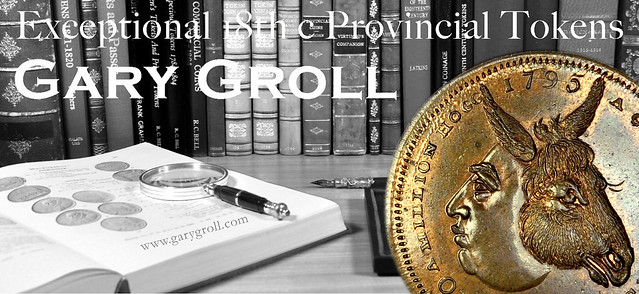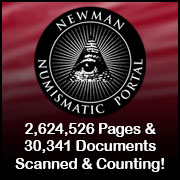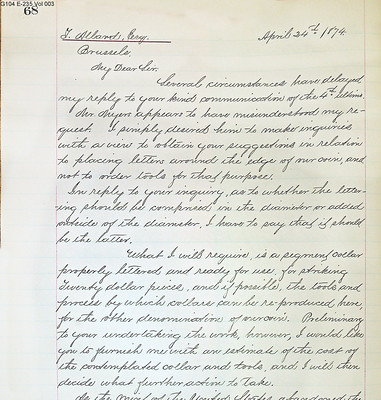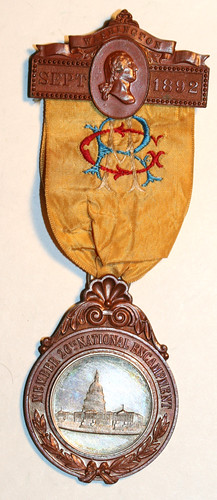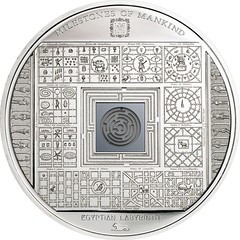
About UsThe Numismatic Bibliomania Society is a non-profit association devoted to the study and enjoyment of numismatic literature. For more information please see our web site at coinbooks.org SubscriptionsThose wishing to become new E-Sylum subscribers (or wishing to Unsubscribe) can go to the following web page link MembershipThere is a membership application available on the web site Membership Application To join, print the application and return it with your check to the address printed on the application. Print/Digital membership is $40 to addresses in the U.S., and $60 elsewhere. A digital-only membership is available for $25. For those without web access, write to: Charles Heck, Treasurer AsylumFor Asylum mailing address changes and other membership questions, contact Chuck at this email address: treasurer@coinbooks.org SubmissionsTo submit items for publication in The E-Sylum, write to the Editor at this address: whomren@gmail.com
BUY THE BOOK BEFORE THE COINSale Calendar
|
- WAYNE'S WORDS: THE E-SYLUM SEPTEMBER 13, 2020
- RICHARD STOCKLEY BOOKS OFFERS PRICELISTS
- NEW BOOK: AAFES - POGS ILLUSTRATED CATALOG
- NEW BOOK: MONEY
- NEW BOOK: THE THREE TYPES OF CURRENCY
- BANKNOTE BOOK FINLAND CHAPTER PUBLISHED
- COIN BOARD NEWS FALL 2020 ISSUE PUBLISHED
- OWNERSHIP CHANGE FOR E&T KOINTAINER COMPANY
- NNP SYMPOSIUM VIDEOS AVAILABLE
- MACNEIL’S NOTES NOW ON NEWMAN PORTAL
- GOLDBERG’S SALE FEATURES HAWAIIANA
- VIDEO: FRANKLIN MINT- OF ART AND MINTING
- U.S. MINT DOCUMENT TRANSCRIPTION UPDATE
- 1892 WASHINGTON, DC GAR ENCAMPMENT BADGE
- NOTES FROM E-SYLUM READERS: SEPTEMBER 13, 2020
- ILLUSTRATOR F. W. FAIRHOLT AND SIR JOHN EVANS
- NEW YORK HORTICULTURAL SOCIETY MEDAL
- MORE ON VICTOR DAVID BRENNER SCULPTURES
- VOCABULARY TERM: MORTUARY MEDAL
- FR. ATHANASIUS KIRCHER, S. J. (1602-1680)
- HARVEY STACK'S NUMISMATIC FAMILY, PART 78
- DONALD PARTRICK AND THE FREDERICK TAYLOR SALE
- SEPTEMBER, 2020 GOLDBERG SALE SELECTIONS
- E PLURIBUS UNUM COLLECTION SALE, PART 2
- NGC DONALD G. PARTRICK COLLECTION IMAGE GALLERY
- NUMISMATIC AUCTIONS LLC SALE 65
- MEDAL OF HONOR FOR FREEING 70 ISIS CAPTIVES
- MUSEUM RECOVERS STOLEN BANKNOTE SKETCHES
- TUNISIA BANKNOTE HONORS FIRST FEMALE PHYSICIAN
- LOOSE CHANGE: SEPTEMBER 13, 2020
- FEATURED WEB PAGE: THE DEXTER 1804 DOLLAR
Click here to access the complete archive
Click here to unsubscribe (scroll down)
To comment or submit articles, reply to whomren@gmail.com
Content presented in The E-Sylum is not necessarily researched or independently fact-checked, and views expressed do not necessarily represent those of the Numismatic Bibliomania Society.
WAYNE'S WORDS: THE E-SYLUM SEPTEMBER 13, 2020
 New subscribers this week include:
Allan Behul, and
Donald Bissex,
Welcome aboard! We now have 6,558 subscribers.
New subscribers this week include:
Allan Behul, and
Donald Bissex,
Welcome aboard! We now have 6,558 subscribers.
Thank you for reading The E-Sylum. If you enjoy it, please send me the email addresses of friends you think may enjoy it as well and I'll send them a subscription. Contact me at whomren@gmail.com anytime regarding your subscription, or questions, comments or suggestions about our content.
This week we open with numismatic literature pricelists, four new books, coin supply news, updates from the Newman Numismatic Portal, and more.
Other topics this week include Standing Liberty Quarters, Hawaiiana, the Franklin Mint, U.S. Mint correspondence, the New York Horticultural Society medal, mortuary medals, the Frederick Taylor sale, upcoming auctions, and the Dexter 1804 Dollar.
To learn more about communion tokens, POGs, the made-up shared fiction of money, banknotes of Finland, the Rail-Splitter Lincoln Cent album, the E&T Kointainer Company, counterfeit slabs, raised lettering on U.S. coins, the 1892 Washington GAR Encampment badge, engraved Lindbergh medals, collecting REALLY rare books, early numismatic author Athanasius Kircher, Higley Threepence, and Laura Gardin Fraser's unadopted Washington Quarter reverse design, read on. Have a great week, everyone!
Wayne Homren
Editor, The E-Sylum
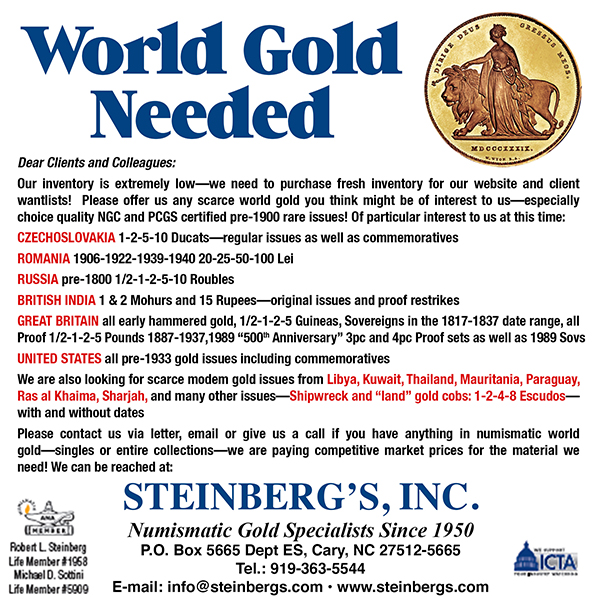
RICHARD STOCKLEY BOOKS OFFERS PRICELISTS
Howard R. Engel is the proprietor of Richard Stockley Books in Winnipeg, specializing in numismatic and philatelic literature. He's prepared a number of specialized price lists, so be sure to contact him about your areas of interest. One needn't be a hardcore bibliophile to find use for a good book or monograph. -Editor
Let me send you price lists of numismatic literature tailored to your collecting interests
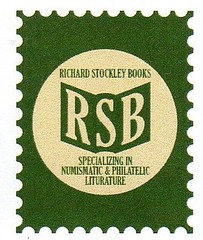 While I could opine the loss of many-a-show since the coronavirus pandemic hit my neck of the woods in Winnipeg, Manitoba, Canada last March (I just received notice from the Edmonton Numismatic Society that they cancelled their fall show scheduled for Nov. 14-15; they were also the first show on my schedule to cancel last March 14-15), if there's one thing the pandemic has taught me for which I am most grateful, it is the importance of becoming more familiar with my stock. In turn, this helps me gain a greater appreciation for what I have and how I can position it to best serve my far-flung customers.
While I could opine the loss of many-a-show since the coronavirus pandemic hit my neck of the woods in Winnipeg, Manitoba, Canada last March (I just received notice from the Edmonton Numismatic Society that they cancelled their fall show scheduled for Nov. 14-15; they were also the first show on my schedule to cancel last March 14-15), if there's one thing the pandemic has taught me for which I am most grateful, it is the importance of becoming more familiar with my stock. In turn, this helps me gain a greater appreciation for what I have and how I can position it to best serve my far-flung customers.
This began with the opportunity the pandemic afforded me to move about 3,000 lbs. of mostly books and equipment from a storage facility to my home at the beginning of May, just before the first anniversary of its shipment from Montreal where the business was domiciled when I purchased it. There's nothing like having everything at your fingertips to get more familiar with it!

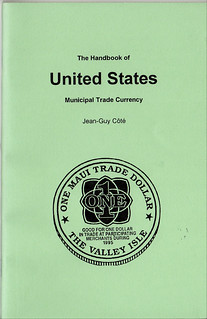
Since I couldn't attend shows, I began developing customized price lists to send my customers, according to their various collecting interests. So far, I've created custom lists on American Numismatic Association reprints, American Civil War Tokens, Canadian Pre-Confederation Tokens, East Asian numismatics (Chinese, Japanese, Korean, Philippine, etc.), TAMS publications, U.S. ephemeral and obscure, World Medals (including U.S. medals), World Paper Money (including U.S. paper money) and others.
These are the tip of the iceberg. My stock covers the gamut of numismatic literature about ancients, both Canadian and U.S. decimal and exonumia to World coins, medals, tokens and paper money and beyond! Why limit such price lists to just a handful of recipients when they could benefit many more collectors? Enter The E-Sylum as a natural gateway for me to provide this service to a much wider readership. Thanks to editor Wayne Homren's invitation, let me now make this service available to you (a service he himself has already benefited from).
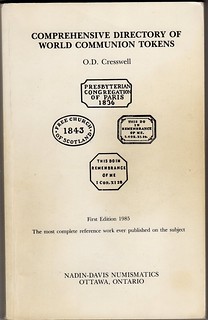
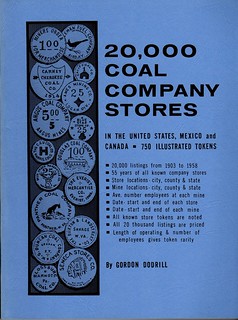
Simply send your request to richardstockleybooks@mymts.net. There's no obligation. You have nothing to lose and you may gain that hard-to-find numismatic publication to add to your collection for a reasonable price. I look forward to delving into my stock to present you an array of desirable numismatic publications that will enhance your experience of the hobby either by better informing you about your own collection or simply by their own intrinsic collectibility.
Howard R. Engel, Proprietor
Richard Stockley Books
Winnipeg, Manitoba, Canada
204-253-0419
To read the earlier E-Sylum article, see:
HOWARD R. ENGEL ACQUIRES RICHARD STOCKLEY BOOKS
(https://www.coinbooks.org/v22/esylum_v22n21a08.html)

NEW BOOK: AAFES - POGS ILLUSTRATED CATALOG
In the September 11, 2020 issue of MPC Gram (the email newsletter for collectors of Military Payment Certificates and other military collectibles), Bill Myers published a short review of a new book by Lloyd Jorgenson the AAFES (Army and Air Force Exchange Systems) gift certificates called POGs. With permission. we're republishing it here. Thanks. -Editor
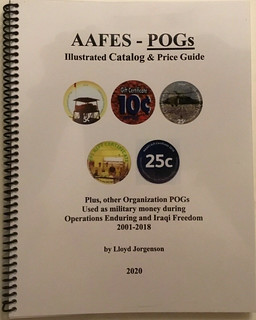 Lloyd Jorgenson has released a color spiral bound book titled AAFES -POGS
Illustrated Catalog and Price Guide in 2020. It has been revised and material
added this recently due to input from other POG collectors. The first edition is
dated August 2020 and the second edition is dated September 2020.
Lloyd Jorgenson has released a color spiral bound book titled AAFES -POGS
Illustrated Catalog and Price Guide in 2020. It has been revised and material
added this recently due to input from other POG collectors. The first edition is
dated August 2020 and the second edition is dated September 2020.
Lloyd starts out with a history of himself and then a dedication. He then discusses what POGs are, followed by a short discussion of the history of Military Money and that includes MPC. He discusses grading and value and error POGs. He then discusses all 16 printings. Lloyd has named each printing and has a one-page discussion of the POGs followed by a color picture of each POG. He then discusses other POGs that were used overseas including EFI and NAAFI. He finishes with a discussion and pictures of POG related items.
There have been other books that list POGs and these include coins and currency of the Middle East: A Descriptive Guide to Pocket Collectibles by Tom Michael and George Cuhaj, The Standard of World Paper Money, Specialized Edition and A Concise Catalog of U.S. Military Payment Certificates by Carlson Chambliss. There may be others I am not aware of.
Lloyd has approached POGs in a different way than the books above and is the only reference I am aware of with color pictures. His book is not just a listing of POGs, he presents a history about POGs and other numismatic items created to support the Global War on Terrorism. This is the only reference I know of that lists the non-AAFES items together in one source. If you collect POGs, you need this book in your library, even if you have the references listed above. And if you do not collect POGS then you should get the book and start collecting them. Try it, you will like it. The number of books printed is small but may be able to be adjusted depending on demand. It is available on eBay - number 283997206684.
From the eBay page:
"AAFES POGs Illustrated Catalog and Price Guide. This book is new with 114 full color glossy pages. This book explains what POGs are, gives a brief history on Military Money, before showing a complete catalog of AAFES POGs, plus British and other Organization POGs that were issued during the Gulf War. The front cover has a clear plastic cover, and the back has a black plastic cover. The size of the book is approximately: 11 X 9 X 1/2 inches. The book is held together with a spiral, which makes it easy to turn pages, as well as hold pages open. This catalog/price guide book is an excellent source of information for beginner and veteran AAFES POG collectors. Ships in the US only. The buyer pays 7.75 for USPS 3-5 day Priority Mail."
For more information, or to order, see:
AAFES POGs Illustrated Catalog and Price Guide
(https://www.ebay.com/itm/AAFES-POGs-Illustrated-Catalog-and-Price-Guide/283997206684)
To read earlier E-Sylum articles, see:
NEW BOOK: A CONCISE CATALOG OF U. S. MILITARY PAYMENT CERTIFICATES
(https://www.coinbooks.org/esylum_v15n21a06.html)
BOOK REVIEW: A CONCISE CATALOG OF U.S. MILITARY PAYMENT CERTIFICATES
(https://www.coinbooks.org/esylum_v15n22a05.html)
POG DESIGNER GRANT MORRIS TO SPEAK AT 2013 MPC FEST
(https://www.coinbooks.org/esylum_v16n09a20.html)
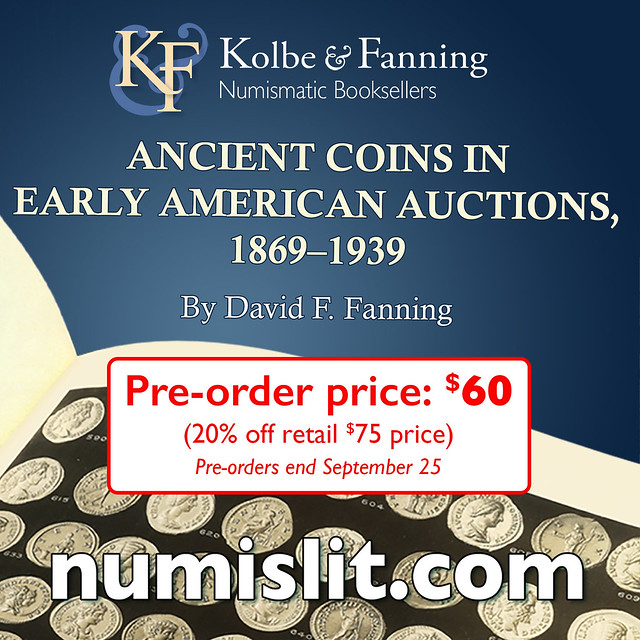
NEW BOOK: MONEY
The New York Times reviewed a new book on the nature of money by Jacob Goldstein. -Editor
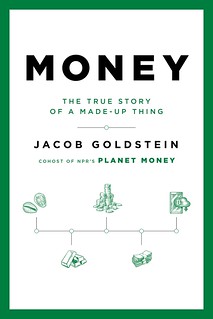 MONEY
MONEY
The True Story of a Made-Up Thing
By Jacob Goldstein
Of all the inventions we rely on to get through the day, nothing is as strange as money. Currency is a national bedrock that sits alongside anthems and flags; our cash — from pristine $100 bills to dog-eared 5 pound notes — seems solid, official and enduring. At the same time money is a confidence trick: an i.o.u. printed on cheap material that promises the holder nothing but more paper money. The evolving paradox of modern currency — foundational yet resting on faith — is the central theme of "Money," a sweeping new history by Jacob Goldstein.
A health reporter during the mid-aughts, Goldstein describes being drawn toward money and economics by the beguiling turbulence of the 2008 crisis. Now a host of NPR’s "Planet Money," he features that show’s trademark storytelling throughout his new book. Histories of money need lots of facts and dates; as a result many are turgid. "Money" is fast-paced and chatty: We meet all the characters an academic book would include, their ideas and innovations blended with scandal and gossip to propel the story along. The effect is a history of currency full of astonishing tales you might tell a friend in the pub.
The main thread is set out right away: Money "seems cold and mathematical and outside the realm of fuzzy human relationships," Goldstein asserts. But it’s really "a made-up thing, a shared fiction. Money is fundamentally, unalterably social." The early chronicles of cash show how societies move from monies with intrinsic value (commodity currencies, like salt, or coins made from precious metal) to paper currencies that are valuable because they are tools — ways to exchange goods and services.
The case of Kublai Khan, the leader of the Mongol empire in the late 1200s, is an early example of this innovation. His first paper money, the "treasure exchange voucher," guaranteed the holder bronze coins. Then the Khan took a magical and modern step, stripping the link with bronze so that his money was "almost pure abstraction, backed by nothing." The success of this currency and those that followed is essentially social: They circulate when everyone in an economy agrees they will.
There is much ground to cover as "Money" moves from traders in Sichuan to goldsmiths in London to investors in the Mississippi Territory. Each treatment is necessarily brief, and some readers may want more detail. But stacking up case studies like this means a bigger story — a recurring pattern — begins to appear. Cash evolves in fits and starts; there are long periods of stability where nothing much happens followed by rapid bursts of change. The Federal Reserve is a case in point: The world’s most important bank exists because of a financial panic in 1907 and decisions taken by a small group of bankers immediately after it. These bursts of innovation happen when the wants, needs and trades in an economy shift. Money changes when society does.
Looking to the future, Goldstein unpicks the origins of bitcoin, a new digital currency that many are betting is the money of tomorrow. Yet he argues that new forms of cash often emerge by accident from unexpected places, rather than by design, as is the case with cryptocurrencies. For this reason, I would have liked a chapter on underground and informal currencies. People living in the world’s toughest economies use all sorts of monies that are "made up." From powdered milk in Syrian refugee camps to prepaid debit cards in United States prisons to pawnshop tickets in postindustrial British cities, a world of hidden currency innovation by economic outsiders exists. These shadow monies too are social, unofficial and come to the fore where the mainstream system fails.
To read the complete article, see:
The Fiction That Makes the World Go Round
(https://www.nytimes.com/2020/09/08/books/review/money-the-true-story-of-a-made-up-thing-jacob-goldstein.html)
THE BOOK BAZARRE
NEW BOOK: THE THREE TYPES OF CURRENCY
A new book has been published by Georges Depeyrot in French and English versions. -Editor
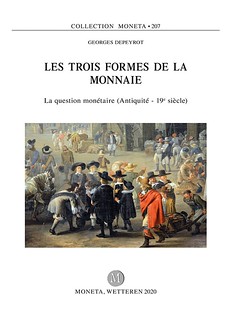
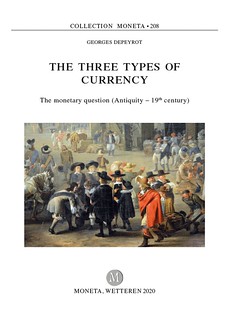
Moneta 208
The three Types of Currency
The monetary question (Antiquity – 19th century)
Georges Depeyrot
Between the creation of currency in the 7th century BC and the general monetization of trade, including the smallest types, during the 19th century, mints were never able to produce enough currencies to meet the needs of people. These needs differed according to social strata, rulers wanted large amounts of currency of high value capable of financing the needs of the countries. When necessary, governments resorted to currency manipulation or debts. Merchants wanted to trade in stable currencies to be able to borrow and lend funds, and above all, to secure themselves against currency devaluations. The population, often deprived of coins, used various currencies, often local. In rural communities, debts were common.
We get the perception of how currencies circulated during that period from various resources. In some cases, these are official documents, which explain the needs of authorities, in other cases, this is ample documentation left by merchants, who took care of their business. The population did not leave much record. Only economists and ecclesiastical texts spoke as if the currency concerned the entire population. Coin finds themselves point to the division in the spheres of exchange. There were silver coins or poor bronze coins, depending on the fortune of their owners.
The study of money therefore requires taking into account the existence of three zones of circulation.
Never in history, has there existed only one currency. On the contrary, there have always coexisted three of them, different and complementary. The prevailing concept was carried by merchants: liberalization of loans and generalization of banks, stability of currencies and units of account, monetization of all social strata.
MONETA 207, 284 pages 85 euros ISBN 978-94-91384-75-2
MONETA 208, 271 pages 85 euros ISBN 978-94-91384-76-9
For more information, or to order, see:
Les trois formes de la monnaie
(http://www.moneta.be/volumes/moneta_207.htm)
The three Types of Currency
(http://www.moneta.be/volumes/moneta_208.htm)

BANKNOTE BOOK FINLAND CHAPTER PUBLISHED
Owen Linzmayer publishes The Banknote Book, a useful, constantly updated electronic reference. The chapter on the banknotes of Finland (primarily authored by Mark Irwin) is now available for $9.99. -Editor
The Finland chapter of The Banknote Book is now available for individual sale and as a free download to subscribers.
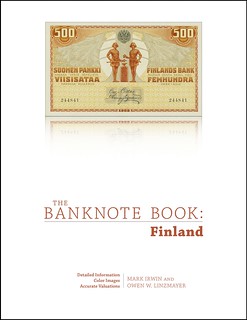 Finland (Europe)
Finland (Europe)
This 53-page catalog covers notes issued by the Storfurstendömet Finlands Wäxel- Låne- och Depositions-Contor (Grand Duchy of Finland Office for Exchange, Loans, and Deposits) from 1812 to 1821, Storfurstendömet Finlands Wäxel- Depositions- och Låne-Bank (Grand Duchy of Finland Bank for Exchange, Deposits, and Loans) from 1818 to 1840, Финляндскій ?'анкъ, Finlands Bank (Bank of Finland) from 1840 to 1997, Suomen Yhdyspankki, Föreningsbanken i Finland (Union Bank of Finland) from 1866 to 1882, and Vaasan Osake Pankki, Wasa Aktie Bank, (Vaasa Equity Bank) in 1918. Published 10.09.2020.
Currently 292 chapters of The Banknote Book have been published as individual high-resolution PDF files. This represents a total of 6,933 pages covering 65,406 types and varieties.
For more information, or to order, see:
https://banknotenews.com/?page_id=18835
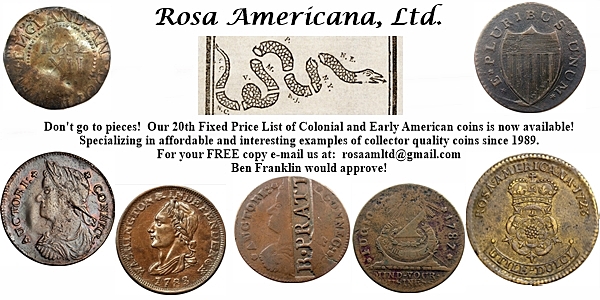
COIN BOARD NEWS FALL 2020 ISSUE PUBLISHED
The Fall 2020 issue of author David Lange's Coin Board News has been published. With permission, here are a few excerpts. -Editor
COVID-19 ISSUES DELAY ARRIVAL SIX WEEKS
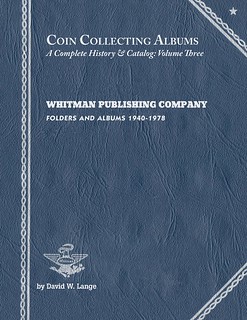 Yes, after being twice delayed at the printer by the ongoing pandemic,
Volume Three in my trilogy of comprehensive books detailing coin
album publishers and their product lines has finally arrived, and all
existing orders have been delivered. Titled Coin Collecting Albums—A
Complete History & Catalog, Volume Three: Whitman Publishing
Company Folders and Albums 1940-1978, this beautiful hardcover, full-
color book came in at 343 pages and four pounds! I’m delighted with the
finished product, and the comments from buyers seem to validate this
pride. Ordering instructions may be found ... at my website:
coincollectingboards.com.
Yes, after being twice delayed at the printer by the ongoing pandemic,
Volume Three in my trilogy of comprehensive books detailing coin
album publishers and their product lines has finally arrived, and all
existing orders have been delivered. Titled Coin Collecting Albums—A
Complete History & Catalog, Volume Three: Whitman Publishing
Company Folders and Albums 1940-1978, this beautiful hardcover, full-
color book came in at 343 pages and four pounds! I’m delighted with the
finished product, and the comments from buyers seem to validate this
pride. Ordering instructions may be found ... at my website:
coincollectingboards.com.
In celebration of the new book I’m including with this newsletter an illustrated list of vintage Whitman coin folders for sale. All are identified by the Lange Numbers found in the book, which will be the new standard for collectors going forward. The list includes rare First and Second Edition folders across several grades. The time to acquire these is now, for prices will almost certainly rise with the book’s publication, just as they did for coin boards after my 2007 book on that subject.
THE WAY COOL DEPARTMENT
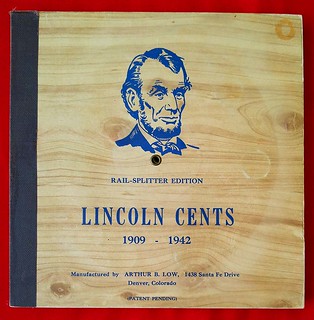 My collection of coin albums includes a few one-off items that defy
ordinary classification. Illustrated here is one such product, the "RAIL-SPLITTER EDITION" coin album for
Lincoln Cents that was produced in 1940 by a fellow named Arthur B. Low of Denver; he received a patent for it
two years later. His patent drawing may be found online, and this accompanies photos I shot of my own example,
which is the finer of just two seen to date. One can scarcely imagine what effect wooden pages had on the coins!
My collection of coin albums includes a few one-off items that defy
ordinary classification. Illustrated here is one such product, the "RAIL-SPLITTER EDITION" coin album for
Lincoln Cents that was produced in 1940 by a fellow named Arthur B. Low of Denver; he received a patent for it
two years later. His patent drawing may be found online, and this accompanies photos I shot of my own example,
which is the finer of just two seen to date. One can scarcely imagine what effect wooden pages had on the coins!
The cents are held within a fiberboard disc that is punched with openings of the appropriate size. A clear plastic window revolves around a brass grommet and has two ports that line up with the two rows of openings. By steering this window using the raised, red plastic tab the ports may be stopped over any desired date/mint opening to add and remove cents. Though a clever product, it didn’t allow for additional dates and likely succumbed to the wartime shortage of materials that played havoc with Raymond, Whitman and other album manufacturers.
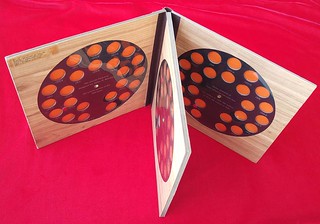
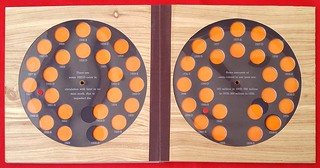
A PASSING
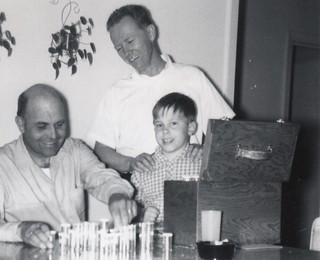 One photo that I nearly included in my new
book about Whitman folders and albums but omitted at the last
moment is a very personal image that captures a glorious
moment in my childhood. It was taken by my brother in May of
1967, shortly after he received a camera for his birthday. The
fellow at left is Bob, who lived next door and was the
neighborhood "collector of all things." Not visible in the photo
are my two Whitman folders lying atop the kitchen table, as Bob
fills most of the missing dates from his forest of tubes. My
father stands behind me, sharing in my joy, as he did so many
times. In August, Dad succumbed to Covid-19 at the age of 95,
but I’ll always remember his unceasing kindness and patience in
indulging my childhood activities.
One photo that I nearly included in my new
book about Whitman folders and albums but omitted at the last
moment is a very personal image that captures a glorious
moment in my childhood. It was taken by my brother in May of
1967, shortly after he received a camera for his birthday. The
fellow at left is Bob, who lived next door and was the
neighborhood "collector of all things." Not visible in the photo
are my two Whitman folders lying atop the kitchen table, as Bob
fills most of the missing dates from his forest of tubes. My
father stands behind me, sharing in my joy, as he did so many
times. In August, Dad succumbed to Covid-19 at the age of 95,
but I’ll always remember his unceasing kindness and patience in
indulging my childhood activities.
We're very sorry for your loss. Great photo! -Editor
To visit Dave's website, see:
http://www.coincollectingboards.com/
To read the earlier E-Sylum article on Dave's great new book, see:
NEW BOOK: COIN COLLECTING ALBUMS, VOLUME THREE
(https://www.coinbooks.org/v23/esylum_v23n25a03.html)
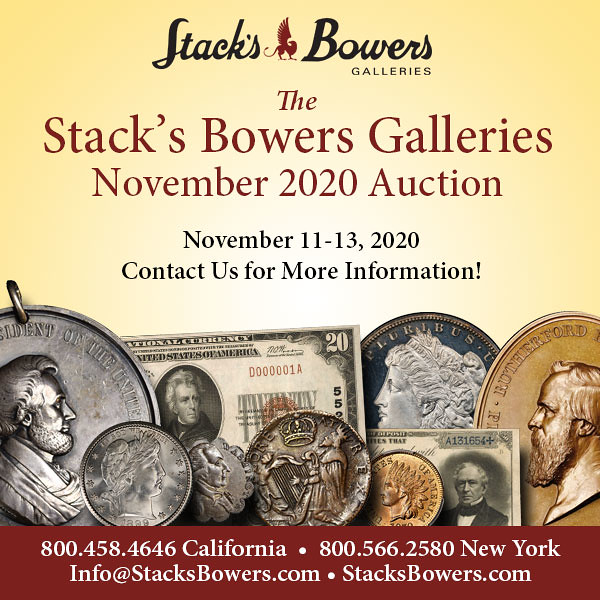
OWNERSHIP CHANGE FOR E&T KOINTAINER COMPANY
Bern Nagengast submitted this news release and historical background concerning the E&T Kointainer company. Thanks! Pictured is a BU cent that has been in a Kointain for 62 years. -Editor
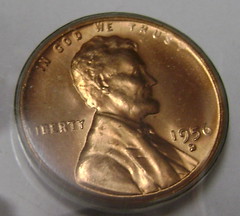 The E&T Kointainer Company, provider of archivally safe numismatic storage products,
has a new owner.
The E&T Kointainer Company, provider of archivally safe numismatic storage products,
has a new owner.
Bernard A. Nagengast, who has owned the company for 41 years, is retiring. Mr. Randy A. Moore, who has been associated with Mr. Nagengast and E&T Kointainer for the last 11 years, has purchased the business and will continue to offer the same quality products numismatists have been using from this American company since 1950. The product line includes Kointain and Saflip coin holders, Safgard currency sleeves, Metal Safe corrosion inhibitor, Koinpage generic coin album, and other accessories.
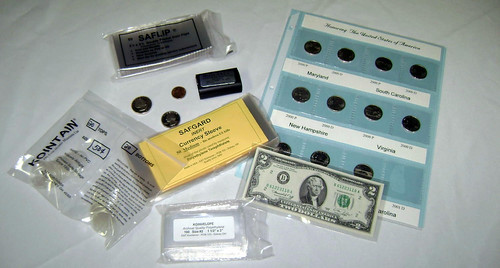
E&T Kointainer sells only numismatic products that will not harm coins and paper money. The company has a history of important innovations in numismatic storage with many firsts that include the Kointain coin capsule, Saflip, the first non-PVC coin flip, the earliest plastic coin tubes and the use of inhibitors to prevent toning of coins. Collectors interested in investigating Kointainer products can access the company website at www.vcoins.com/us/kointainer. Catalog requests can be sent to Randy Moore at plantman55@icloud.com or mailed to E&T Kointainer, PO Box 103, Sidney OH 45365.
Best of luck and continued success for the new owner. Here's the historical background, written by Bern Nagengast. Thanks. -Editor
Profile of a pioneer in numismatic storage
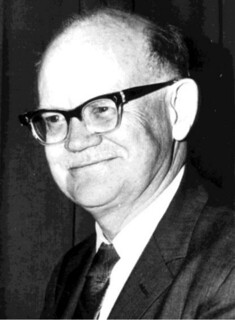 More than fifty years ago a southern US collector purchased a proof 1856 Flying
Eagle cent. Within a year, the coin was spotted. The horrified collector, Dr. Francis Stevens Epps, suspected that the coin holder had ruined his expensive coin and he
decided to do something about it. Enlisting the help of a friend who was a research
chemist, Dr. Epps began investigating the methods and devices used to store coins. He
concluded that then-used holders were unsuitable and damaging to coins, and he set out
to invent the perfect coin holder. The result was the KOINTAIN; a round plastic holder
made of inert materials, convex in shape so as to touch the coin only on its edges. The
holder was thin enough to appear almost invisible at a distance.
More than fifty years ago a southern US collector purchased a proof 1856 Flying
Eagle cent. Within a year, the coin was spotted. The horrified collector, Dr. Francis Stevens Epps, suspected that the coin holder had ruined his expensive coin and he
decided to do something about it. Enlisting the help of a friend who was a research
chemist, Dr. Epps began investigating the methods and devices used to store coins. He
concluded that then-used holders were unsuitable and damaging to coins, and he set out
to invent the perfect coin holder. The result was the KOINTAIN; a round plastic holder
made of inert materials, convex in shape so as to touch the coin only on its edges. The
holder was thin enough to appear almost invisible at a distance.
Dr. Epps organized E&T Kointainer Company in 1950 to market the new coin holder. The E & T in the name was derived from Epps and Trainer, Mr. Trainer being the other partner in the company. The two men first offered a Kointain for cents, expanding the offerings to include all major US denominations over the next few years.
The Kointain was not Dr. Epps’ only innovation. Realizing that storage of BU rolls in paper wrappers was unsuitable; Dr. Epps invented the plastic coin tube in the mid-1950’s. The first plastic tubes were plastic pill bottles, selected so that the diameter and length closely matched the various coin roll sizes. Later, custom tubes with caps at each end were introduced.
Cellophane envelopes were widely used to store coins, even being used by the U.S. Mint for proof coins prior to 1955. However cellophane released sulfur fumes and became brittle with age. Dr. Epps’ solution was the KOINVELOPE; an envelope made of polyethylene. This type of envelope, widely used by coin auction houses as late as the early 1970’s, is still used by collectors today as a short-term protection for coins in PVC flips.
Dr. Epps passed away in 1973 at age 70. Along the way, the coin-storage inventor found the time to found two coin clubs in West Virginia and Michigan and write numerous articles on coin preservation. He was active for 18 years in the Central States Numismatic Society serving as secretary, president and secretary-treasurer. When Dr. Epps retired from official CSNS duties at their 34th. Convention in 1973, the assembly sang "For he’s a jolly good fellow" followed by a standing ovation. After he died, Dr. Epps was remembered not only as a "recognized expert on the chemistry of plastics to protect coins" but also as one "active in every phase and in spreading the word of the hobby to almost every person he met."
Epps’ successors at E & T Kointainer have continued the legacy of numismatic storage innovation that focuses on quality and safety. Space-age technology debuted in numismatics in 1978 when METAL SAFE, an atmospheric corrosion inhibitor for safes and safety deposit boxes, was first sold. PVC "green slime" problems led to the introduction of DISSOLVE neutral coin solvent in 1979. An improved product, KOINSOLV, was later introduced. In 1980, the danger of PVC flips was met with the first MYLAR TM flip, the SAFLIP.
The KOINPAGE album was announced in 1998. The album features inert, non-vinyl plastic pages with slide in coin pockets and acid free title-date strips. The pages, separated by acid and sulfur free divider pages, hold any combination of coins in a 3-ring binder, allowing flexibility in the size of the collection.
Dr. Epps’ legacy of products are still used not only by collectors, but by libraries and museums including The Smithsonian Institution, The ANA Money Museum, The American Numismatic Society, Harvard, Princeton, James Madison, Cornell and Michigan Universities. And yes, Dr. Epps original invention, the Kointain, is still available, finding use with 1856 Flying Eagle cents and with state quarters and Sacagawea dollars as well.
A complete catalog of numismatic storage products is available by sending a self-addressed, stamped envelope to Kointainer, POB 103, Sidney, OH 45365-4128.
Bern adds:
"After 41 years I am retiring from the coin supply business (but I'm not retiring from Numismatics!). I would expect some subscribers either knew Dr. Epps or had heard of him."
Thanks again for the great information. Can anyone share stories of Dr. Epps and/or their use of E & T products? -Editor
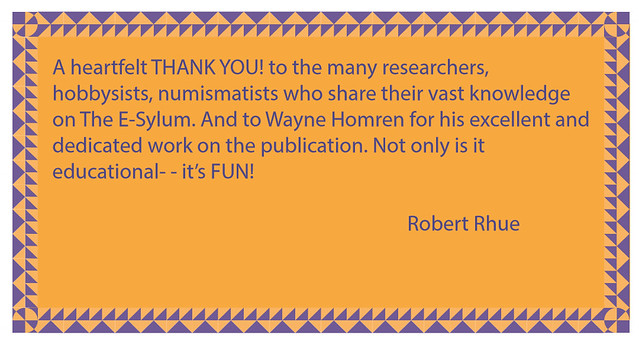
NNP SYMPOSIUM VIDEOS AVAILABLE
The first NNP Symposium is history, and turned out to be quite a success. Kudos to everyone involved, from the organizers and speakers to the participants who attended and asked some great questions. I was pleased to have the opportunity to speak, and the session went quite smoothly.
Here's the post-event announcement; the videos are available now and forever on the Newman Portal. Share links to your favorite talks with your friends, or take a break and watch some of the talks you missed at the time. We'll all look forward to the next event. -Editor
Newman Numismatic Portal Symposium Videos Available
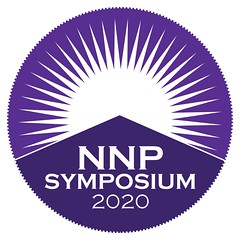 Videos from the recently conducted Newman Numismatic Portal (NNP) Symposium are now available on the Newman Numismatic Portal at
https://nnp.wustl.edu/library/multimediadetail/
Videos from the recently conducted Newman Numismatic Portal (NNP) Symposium are now available on the Newman Numismatic Portal at
https://nnp.wustl.edu/library/multimediadetail/
539070. The NNP Symposium, held August 28-30, featured an online series of numismatic presentations over a three-day period. The event, which drew over a thousand registrants, included forty-one sessions and presented a wide array of content, including American, world, and ancient numismatics. This event was produced by Lianna Spurrier of Numismatic Marketing, under sponsorship of the Eric P. Newman Numismatic Education Society.
Attendee input was enthusiastic, with one viewer noting "Drive time was very short, parking was free, food options were plentiful and reasonably priced, and overnight accommodations were like sleeping in my own bed." Another commented "I just want to tell you what a fabulous event the Symposium was, as I’m sure you have heard a hundred times. It was an oasis in the COVID-19 desert — it got the coin collecting juices flowing again for those of us hunkered down waiting for the next show." Other comments received included "These last three days were the closest I've come to having a coin convention experience since before the coronavirus hit" and "The NNP hit a homerun with its effort. The symposium was such a success that I hope the NNP makes this an annual event."
Popular sessions included Greg Rohan, of Heritage Auctions, who discussed the impact of the COVID epidemic on the numismatic market. Charles Morgan presented on "Five Ways to Modernize the Rare Coin Market," while Matthew Tavory and Isaiah Hagemen hosted a well-received discussion on detection of counterfeit slabs. Rounding out the most attended presentations, Robert Rodriguez spoke on the "The 1792 Morris ‘So-Called’ Silver Center Cent."
The growth of online numismatics mirrors that of nearly every other industry, and the unique circumstances of the present epidemic make events such as Newman Numismatic Portal Symposium particularly appropriate in the present environment. "I was encouraged to see the numismatic community come together in this way," noted Len Augsburger, Project Coordinator for the Newman Numismatic Portal. Andy Newman, Trustee of the Eric P. Newman Numismatic Education Society, commented "There appears to have been an appetite for numismatic content presented in this format, so we are encouraged to continue facilitating such events and welcome suggestions for improvement."
Comments regarding this or future events are welcome by email, at NNPCurator@wustl.edu.
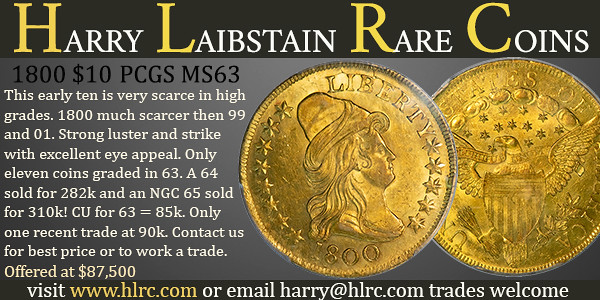
MACNEIL’S NOTES NOW ON NEWMAN PORTAL
The latest addition to the Newman Numismatic Portal is the Standing Liberty Quarter journal MacNeil’s Notes. Project Coordinator Len Augsburger provided the following report. -Editor
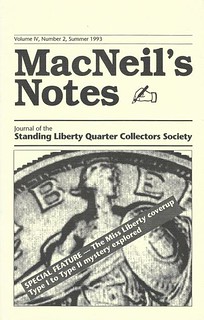 The Standing Liberty Quarter Collectors Society (SLQCS), active from 1990-1994, published MacNeil’s Notes, which covered a host of issues related to the Standing Liberty quarter dollar series (1916-1930). These journals, courtesy of SLQCS President Joe Abbin, are now available on Newman Portal. All aspects of the coin are covered, including population studies, strike characteristics, Herman MacNeil biography, and of course the infamous Type II design introduced in 1917, which is extensively discussed in the Summer 1993 issue.
The Standing Liberty Quarter Collectors Society (SLQCS), active from 1990-1994, published MacNeil’s Notes, which covered a host of issues related to the Standing Liberty quarter dollar series (1916-1930). These journals, courtesy of SLQCS President Joe Abbin, are now available on Newman Portal. All aspects of the coin are covered, including population studies, strike characteristics, Herman MacNeil biography, and of course the infamous Type II design introduced in 1917, which is extensively discussed in the Summer 1993 issue.
Attributed by Walter Breen and others to Puritan sensibilities, the more modest appearance of Liberty beginning in 1917 was in fact driven by less lurid concerns. Roger Burdette, in Renaissance of the American Coinage, came to the same conclusion. As Kellen Hoard noted in his recent NNP Symposium presentation, even false stories can have power, and Breen’s is so natural and believable that it is difficult to drive the factual version into the public consciousness. NNP acknowledges Joe Abbin for his assistance with this title.
Image: MacNeil’s Notes Summer 1993 cover, with strategically placed caption
Link to MacNeil’s Notes on Newman Portal:
https://nnp.wustl.edu/library/publisherdetail/538969

GOLDBERG’S SALE FEATURES HAWAIIANA
Newman Numismatic Portal Project Coordinator Len Augsburger provided this report on the upcoming sale of some interesting Hawaiiana from the Eclectic Numismatic Treasure collection images on NNP. Thanks. I added the image of a Hawaiian Dollar reverse for comparison. -Editor
Goldberg’s Pre-Long Beach Sale Features Hawaiiana
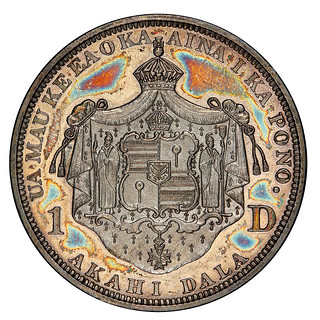
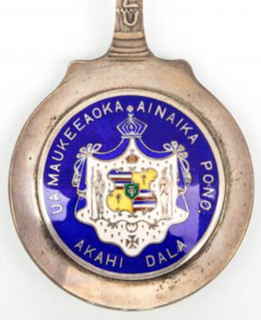
A group of Hawaiian exonumia appears in Goldberg’s Pre-Long Beach sale on September 13. Lots 1002-1061 feature an extensive enameled spoon collection in addition to toddy ladles, tableware, and a cane featuring an 1883 Hawaiian dollar. Originating from the Eclectic Numismatic Treasure collection, many of these pieces are unique or nearly so.
Lot 1029, for example, is an enameled spoon produced by Charles M. Robbins Co. The Hawaiian coins were produced in San Francisco and are included in standard references such as the Guide Book of United States Coins.
Image: Lot 1029, Hawaiian 1883 enameled dollar spoon in Goldberg’s 9/2020 sale.
Link to Hawaiiana in Goldberg’s Pre-Long Beach sale:
https://www.goldbergcoins.com/view-auctions/catalog/id/73/?page=21
Link to Eclectic Numismatic Treasure image collections on Newman Portal:
https://nnp.wustl.edu/library/imagecollections?hpp=true&page=14&searchletter=E

VIDEO: FRANKLIN MINT- OF ART AND MINTING
With the assistance of David Lisot, the Newman Portal has added a 1971 video on the Franklin Mint. All of David’s videos are on the NNP website at:
https://nnp.wustl.edu/library/multimediadetail/522852
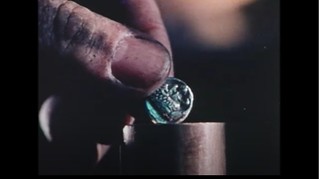 Of Art and Minting (1971)
Of Art and Minting (1971)
Produced by the Franklin Mint
VIDEO: 28:07.
One of the earlier films devoted to the creating of coins and medals, this video has the highest production value of its time. Although a shameless publicity piece for the Franklin Mint it has some of the best graphics and numismatic photography. The Franklin Mint was a private minting facility that designed numerous medal series for sales to the public and coins for foreign countries. Some of their finest work was done when they hired former chief US Mint engraver Gilroy Roberts.
The video is available for viewing on NNP at:
https://nnp.wustl.edu/library/book/584177
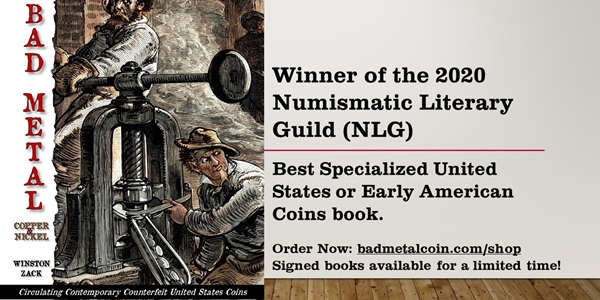
U.S. MINT DOCUMENT TRANSCRIPTION UPDATE
Roger W Burdette writes:
"To date the US Mint document transcribers have completed almost 400 documents. These range from telegrams and single page letters, to 25-page technical reports and data tables. Here is an excerpt from a letter sent by Mint Director Linderman to the Mint of Belgium regarding possible use of raised lettering on U.S. coins.
"Every transcription is important in unlocking the real history of United States coinage and its role in the American financial system.
"New volunteers are welcome."
J. Allard, Esq. Brussels
My Dear Sir:
Several circumstances have delayed my reply to your kind communication of the 4th ultimo.
Mr. Myers appears to have misunderstood my request. I simply desired him to make inquires with a view to obtain your suggestions in relation to placing letters around the edge of our coin, and not to order tools for that purpose.
In reply to your inquiry, as to whether the lettering should be comprised in the diameter or added outside of the diameter, I have to say that it should be the latter.
What I will require, is a segment collar properly lettered and ready for use for striking twenty dollar pieces, and if possible, the tools and process by which collars can be re-produced here, for the other denominations of our coins. Preliminary to your undertaking the work, however, I would like you to furnish me with an estimate of the cost of the contemplated collar and tools, and I will then decide what further action to take.
Want to help with this great project? Let me know and I'll pass your information on to Roger. I can be reached at whomren@gmail.com . -Editor
To read the earlier E-Sylum articles, see:
JOIN NATIONAL ARCHIVES TRANSCRIPTION INITIATIVE
(https://www.coinbooks.org/v23/esylum_v23n13a09.html)
NATIONAL ARCHIVES TRANSCRIPTION UPDATE
(https://www.coinbooks.org/v23/esylum_v23n14a20.html)
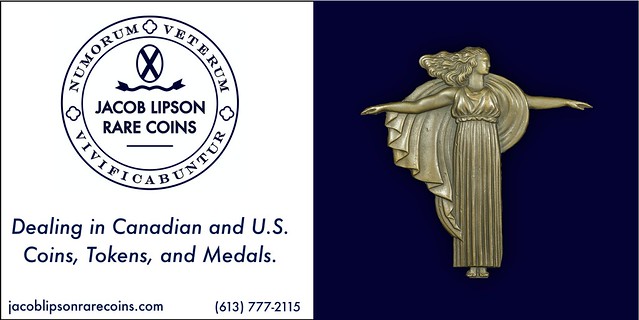
1892 WASHINGTON, DC GAR ENCAMPMENT BADGE
Last week Jonathan Brecher asked about a medal depicting the 1865 Grand Review of the Armies, wondering if it was contemporary with the event or produced later, for example in conjunction with a Grand Army of the Republic (GAR) encampment. As usual, E-Sylum readers came through with answers. -Editor
Julia Casey writes:
"I searched newspaper databases and came across this reference from the June 17, 1892 Evening Star of Washington D.C., about the G.A.R. encampment badge.
"I also found an image of this complete badge on Worthpoint."
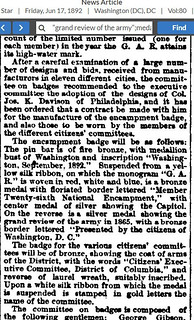
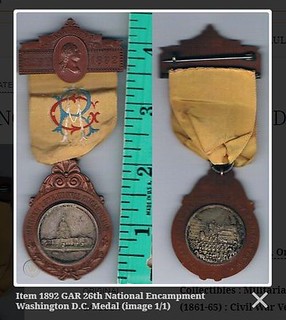
After a careful examination of a large number of designs and bids, received from manufacturers in eleven different cities, the committee on badges recommended to the executive committee the adoption of the designs of Col. Jos. K. Davison of Philadelphia, and it has been ordered that a contract be made with him for the manufacture of the encampment badge, and also those to be worn by the members of the different citizens' committees.
The encampment badge will be as follows: The pin bar is of fire bronze, with medallion bust of Washington and inscription "Washington, September, 1892." Suspended from a yellow silk ribbon, on which the monogram "G.A.R." is woven in red, white and blue, is a bronze medal with floriated border lettered "Member Twenty-sixth National Encampment," with center medal of silver showing the Capitol. On the reverse is a silver medal showing the grand review of the army in 1865, with a bronze border lettered "Presented by the citizens of Washington, D.C."
Dave Schenkman concurs. -Editor
"That "1865 Grand Review of the Armies Medal" is actually an inset in the 1892 Washington, DC national encampment medal/badge.
"I did a series of articles on the four GAR national encampments held in Washington, DC; 1892, 1902, 1915, and 1936. The 1892 article illustrated 35 medals and 38 ribbons.
"The GAR was an organization destined for extinction from the start, since only those who served during the Civil War were eligible for admission. Therefore, as time passed fewer and fewer members attended the encampments. The final one was in 1949, and only six members attended."
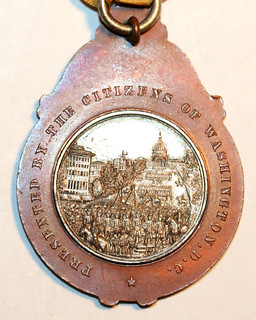
Jonathan Brecher writes:
"Neat. At least I was on the right track, even if I didn't go far enough. Thanks to all!"
Thanks, everyone! -Editor
To read the earlier E-Sylum article, see:
NOTES FROM E-SYLUM READERS: SEPTEMBER 6, 2020 : 1865 Grand Review of the Armies Medal
(https://www.coinbooks.org/v23/esylum_v23n36a12.html)

NOTES FROM E-SYLUM READERS: SEPTEMBER 13, 2020
Elder's James Wilson Saleroom Photo
Dave Hirt writes:
"I was happy to read that the NBS auction did so well. As a former officer, the NBS is dear to my heart. As I read that the Virgil Brand copy of Elder's James Wilson sale got the top bid, I looked up at a framed picture in my library.
"The night before the Wilson sale, Tom Elder held a banquet for the the sale attendees. Virgil Brand is in this picture. It was one of the few times he ever left Chicago. There are 31 individuals pictured. They really are the whose who of numismatics at that time, 1908. Most in the picture are identified. I was able to identify two or three more. Brand is seated at the table, next to his very good friend, "Uncle Joe" Mitchelson."
A great photo and super documentation of an era of numismatic history. -Editor
To read the earlier E-Sylum article, see:
2020 NBS BENEFIT AUCTION RESULTS
(https://www.coinbooks.org/v23/esylum_v23n36a02.html)
The Nation of Celestial Space
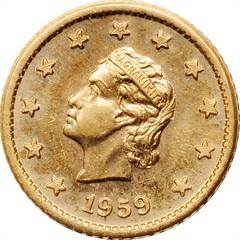
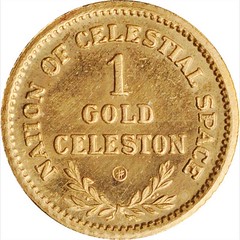
Regarding the "Trash Isles" micronation currency, Paul Bosco writes:
"This reminds one of The Nation of Celestial Space, a/k/a/Celestia, founded 1948. It issued a few coins around 1960, which are listed in Colin Bruce's Unusual World Coins. Its founder, James Thomas Mangan of Evergreen Park, Illinois, sought to preserve the benefits of outer space for all mankind by placing all of the universe, Earth excepted, under his own wise rule. Mangan (d.1970) was not particularly nutty, but evidently was not immune to having some fun.
"A decent web entry: http://chiefacoins.com/Database/Micro-Nations/Celestia.htm.
"Another, from the Smithsonian: https://americanhistory.si.edu/blog/celestia-coins.
"There is also the expected Wikipedia page.
"His coins in silver brings a few 10s of dollars, the gold ones (2.2gms) a few hundred.
"While my little note gives few chances to err, I believe it is apostrophically unimpeachable.
"There are also coins for the geographically-challenged nations of Europa and Esperanto."
Thanks! Every now and then at an ANA convention, someone will display a set of the coins of The Nation of Celestial Space. A fun set to complete, with examples popping up on eBay and coin auctions periodically. Maybe now exhibitors will augment the sets with challenge coins of the new U.S. Space Force. -Editor
To read the earlier E-Sylum articles, see:
TRASH ISLES MICRONATION BANKNOTES
(https://www.coinbooks.org/v23/esylum_v23n36a29.html)
MICRONATION STATECRAFT FOR DUMMIES
(https://www.coinbooks.org/esylum_v17n43a21.html)
LOOSE CHANGE: SEPTEMBER 6, 2020 : A History of Punctuation
(https://www.coinbooks.org/v23/esylum_v23n36a32.html)
Query: Engraved Charles Lindbergh Medals
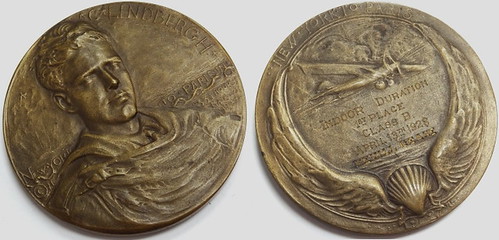
Steve Bishop writes:
"I'd like the help of The E-Sylum's readers regarding a topic I am researching.
I have seen or own examples of the Hinton-designed medal honoring Charles Lindbergh used as award medals by adding engraving noting the achievement of the recipient. I am interested in hearing from anybody who has or has seen one of these, or any commemorative medal (as opposed to one specifically designed for it), used for this purpose.
"I note two types so far. The first one pictured is simply engraved with the additional information. The second type is one in which the original design has had part of the information included in the struck version, with only the specific information, such as name and date, added by engraving. I have seen two examples from Bronxville High School, and one that was used for an indoor flying competition. My email address is wudtrnr@gmail.com."
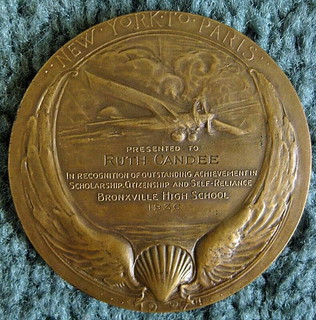
Interesting. Can anyone help? -Editor
Wishing 2020 Was Over
Tom Sheehan passed along this meme I'm sure everyone can relate to. Thanks. -Editor
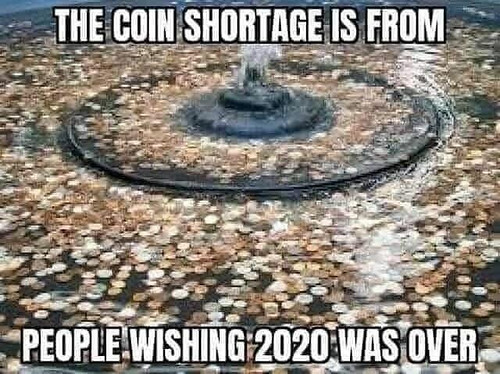
Collecting REALLY Rare Books
I'm not sure if I published this one before, but our hard-core bibliophiles should appreciate the cartoon I came across this week. -Editor
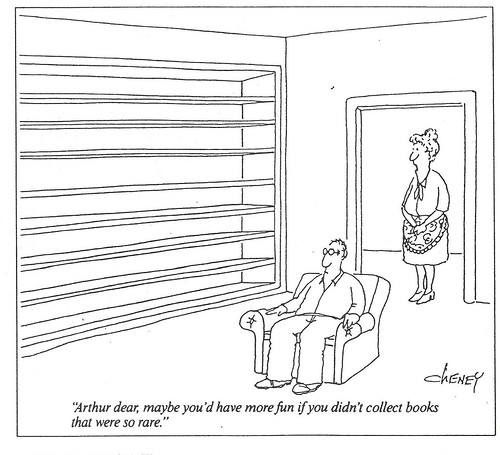
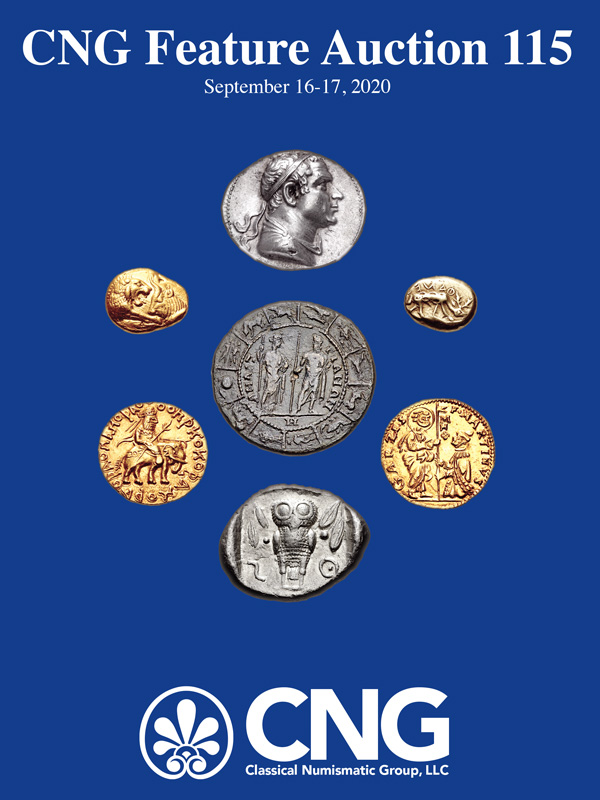
ILLUSTRATOR F. W. FAIRHOLT AND SIR JOHN EVANS
Bob Van Arsdell writes:
"I just published an article on my website that may be interesting to numismatic book collectors and authors.
"Sir John Evans' "Coins of the Ancient Britons" was published in 1864 with illustrations by F. W. Fairholt. Recently, Fairholt's copy of the book surfaced in the inventory of an antiquarian bookseller in Detroit, Michigan. The book was a presentation copy from Evans to Fairholt, and has several letters from Evans tipped into the front endpapers.
"The letters give an idea of the working relationship between an author and an engraver in the 1850s. The plates in the books are all woodcuts. Evans ran into delays when he was promised an sketch of a coin and it didn't show up on time. Work had to stop on a plate until he could track down the missing sketch or the coin, itself. You couldn't cut-and-paste with woodcuts."
Thanks! Here's an excerpt, but see the complete article (and others) online. -Editor
Fairholt appears to have pasted a note from Evans with a coin sketch and findspot details on the front pastedown. On the first side of the first free endpaper, he tipped-in a four-page letter from Evans dated 1860, and onto that another two-page letter from the same year.
These additions give some idea of the working relationship between Evans and Fairholt. Evans mentions the difficulty of obtaining images of coins. This caused delays in completing the work. Fairholt had to cut the images into wood, so every image had to be secured before a plate could be cut. There was no possibility of inserting a coin after the cutting was done. If the images spilled over onto the next plate, delays in cutting that plate would occur. One can see Evans instructing Fairholt to cut parts of a plate, but then to stop and see if a promised image was forthcoming. It was a far cry from today's electronic methods in which images can easily be moved around, inserted and sized to fit a space.
The letters also give some appreciation for the friendship between Evans and Fairholt, with Evans inquiring about Fairholt's health and giving advice about medicines and cures. Fairholt would succumb to tuberculosis in 1866. He did not make any annotations in the book Evans gave him.
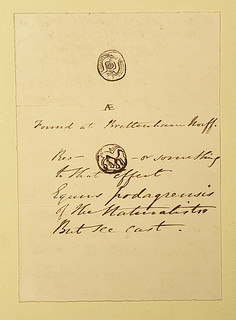 Evans' correspondence with Fairholt – note on pastedown
Evans' correspondence with Fairholt – note on pastedown
Transcription:
(sketch of obverse)
Æ (AE ligatured)
Found at Brettenham Norff.
Rev – (sketch of reverse) – or something to that effect
Equus podagrensis (?) of the Maternalists (?).
But see cast.
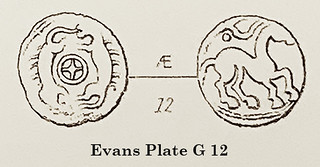 The bronze coin sketched by Evans in the note appears on Fairholt's plate G as number 12. It was deleted from Mack's 1953 catalogue and subsequent writers have not firmly restored it to the British series. Symonds 1990b lists another example (number 5 in the 1990 article), but is uncertain whether it's British or Gaulish. Hobbs 1996 includes it as number 402 on plate 17 as "Early Uninscribed Bronze" but without further speculation about its likely origin. The type needs further research.
The bronze coin sketched by Evans in the note appears on Fairholt's plate G as number 12. It was deleted from Mack's 1953 catalogue and subsequent writers have not firmly restored it to the British series. Symonds 1990b lists another example (number 5 in the 1990 article), but is uncertain whether it's British or Gaulish. Hobbs 1996 includes it as number 402 on plate 17 as "Early Uninscribed Bronze" but without further speculation about its likely origin. The type needs further research.
To read the complete article, see:
Letters to Fairholt
(https://vanarsdellcelticcoinageofbritain.com/articles-numismatic_ccb3/van_arsdell_2020c_ccb3.html)
Bob also passed along these useful articles on woodcuts and wood engraving. Thanks! -Editor
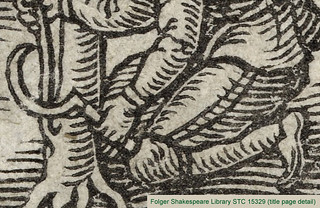 To read the complete articles, see:
To read the complete articles, see:
Woodcut, engraving, or what?
(https://collation.folger.edu/2012/02/woodcut-engraving-or-what/)
Woodcut & Wood Engraving
(http://sites.fas.harvard.edu/~fa106x/Wood/wood.htm)
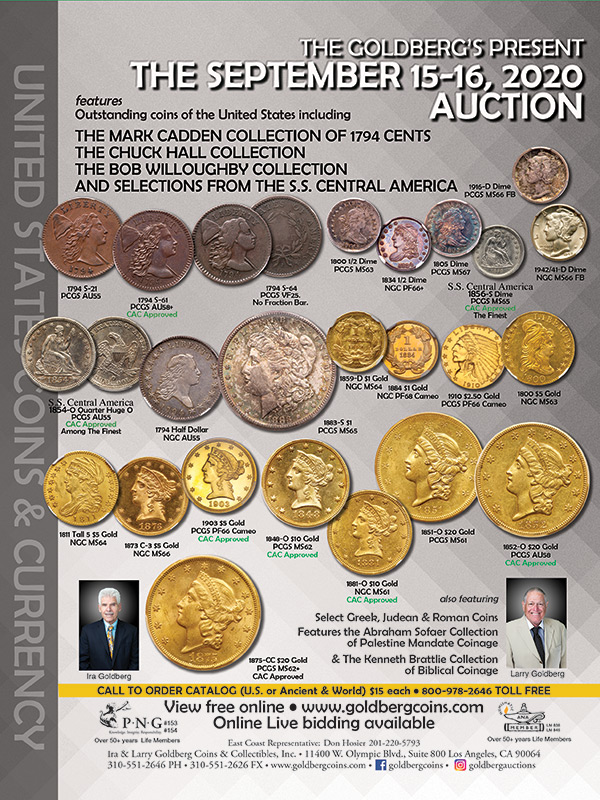
NEW YORK HORTICULTURAL SOCIETY MEDAL
Reader Jerome Nashorn submitted these images and notes on a New York Horticultural Society medal discussed a couple years ago. Thanks! -Editor
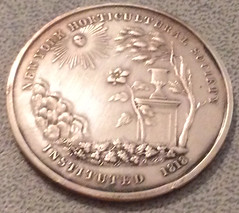
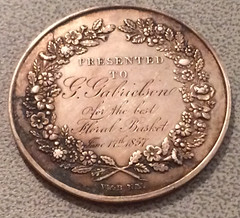
The February 4, 2018, issue of The E-Sylum included an entry, written by Len Augsberger, concerning a medal awarded by the New York Horticultural Society in the middle years of the 19th century. Augsberger's piece incorporated the description of this rare medal written by Joe Levine in 2007 when PCAC Auction 77 included an example, and he closed the article by asking if any E-Sylum readers could provide an image.
I purchased the PCAC example in 2007 and have attached photos. When I read the E-Sylum article 2+ years ago, my collection of New York medals, never very well organized, was in a particularly disorganized state as a result of moving so I didn't even try locating the NYHS medal. I've now gotten things under better control and consequently have finally followed through on this, should anyone still be interested.
As one who particularly collects awarded medals, I have researched the recipient of my example using census records and NYC directories. Gunnar Gabrielson was born in Norway around 1820 and was in New York by the late 1850s. From ca. 1860-1885, he had a flower shop on Broadway at 12th St., across the street from where the Strand Bookstore has operated for decades.
To read the earlier E-Sylum article, see:
NEWMAN PORTAL SEARCH: NEW YORK HORTICULTURAL SOCIETY
(https://www.coinbooks.org/v21/esylum_v21n05a09.html)

MORE ON VICTOR DAVID BRENNER SCULPTURES
Regarding our discussion of sculptures by coin designers, Dick Johnson submitted his compilation of these works by Victor David Brenner. Thanks! -Editor
1900ca. Campi (Louis) Bust (modeled in Turin Italy; Brenner made two trips to Turin, in 1900 and 1901) . . . . . . . .
1900ca. Campi [companion female] Bust (assumed modeled in Turin Italy as well). . . . . . . . . . .
1900ca Young Lovers Statuette (Couples Embracing, Two Groups
patinated bronze, possible bookends) . . . . . . . . . .
Auction: . . . . . . . . . . . . . . New York 31 May 1990 ($3,750)
Archives: Inventory of Am Sculpture . . . . . . IAS75004744
Collection: University of Notre Dame, Indiana. . . . .
1903 Sterne (Simon) Bust [Brenner’s biographical letter states
this statue intended for East New York Cemetery]. . . . .
Archives: Inventory of Am Sculpture . . . . . IAS 07260019
Collection: Baltimore Museum of Art . . . . . IAS 75006054
Collection: New York Public Library . . . . . . IAS 76008648
Collection: Yale University Art Gallery. . . . . . . . .1926.117
Photo: Smithsonian Photo Archives Image . . . . . J0123365
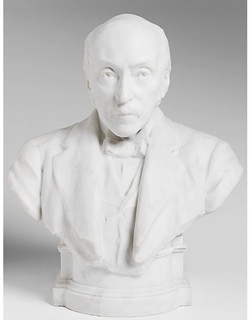 1906 Norton (Charles Eliot) Marble Bust . . . . . . . . .
1906 Norton (Charles Eliot) Marble Bust . . . . . . . . .
Archives: Inventory of Am Sculpture . . . . . IAS 77000402
Collection: Harvard Univ Art Museum (Fogg) . . .. . 1907.3
Illustrated: F28b {1913} Kellog (2 October 1915) page. 22
1908 Cleveland Trust Company Seal (mounted in floor of bank building in Cleveland, gift of Ambrose Swasey, a director of the bank). . . . . . . . . . . . . . .
1908 Emerson (Edwin) Tombstone. . . . . . . . . . . . . .
Photo: Smithsonian Photo Archives Image . . . . . J0123276
1909 Lincoln (Abraham) Bust (owned by the author, DWJ). .
Illustrated: P3 {2007} Coin World (March 26) page 14
Illustrated: N38 {2008} Bowers. Guide Lincoln Cents, p 14
Illustrated: N41{2009} Reed. Lincoln, The Image, p 173
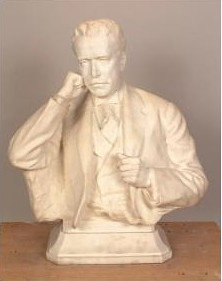 1912 Drummond (Issac Wyman) Marble Bust . . . . . . . Hahlo 148
1912 Drummond (Issac Wyman) Marble Bust . . . . . . . Hahlo 148
Archives: Inventory of Am Sculpture . . . . . IAS 76009044
Collection: New-York Historical Sociey. . . . . .. . . 1946.85
Photo: Smithsonian Photo Archives Image . . . . J0123317
1912 Irving (Washington) Relief Tablet . . . . . . . . . . . . .
Archives: Inventory of Am Sculpture . . . . . IAS 67350060
Collection: New York City Board Educaionn . . . . .
Collection: New-York Historical Society . . . . . . .1949.176
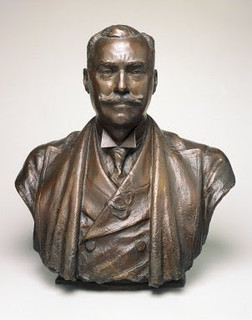 1914 Avery (Samuel Putnam) Bust . . . . . . . . . . . . .
1914 Avery (Samuel Putnam) Bust . . . . . . . . . . . . .
1915(?) Lincoln (Abraham) Gettysburg Address Tablet (cast by Gorham & Co, with circular medallion portrait of Lincoln, also made separate, see above, Cast Medal). . .
1915 Lincoln (Abraham) Relief Portrait (copyright 15 June
1915; cast by Gorham Company; companion to 1921
Washington relief below; Lincoln plaster model was
in Jaspon-Lit collection, now at American Numismatic
Society) . . . . . . . . . . . . . . .
Archives: Inventory of Am Sculpture [>1].IAS 64480059
Collection: American Numismatic Society . . . 1989.17.1
Collection: New York City Board of Education. . . .
Collection: Pittsburgh City-County Building. . . . . .
Photo: Smithsonian Photo Archives Image [>1] J0123320
1915 Swasey (Ambrose) Portrait Relief . . . . . . . . . . Smedley 104
Collection: Denison University Swasey Chapel lobby
1917 New Russia Sculpture . . . . . . . . . . . . . . . . . Photo: Smithsonian Photo Archives Image . . . S0000323
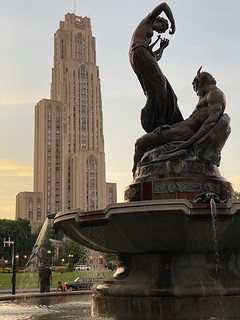 1918 Schenley (Mary E.) Memorial Fountain Sculpture (also
called A Song to Nature) [cast by Jno Williams Inc;
formerly in Schenly Park, Pittsburgh, now in front
of Henry Clay Frick Fine Arts Building, Univ of
Pittsburgh]. . . . . . . . . . . . . . . . . . . . . . . . . . . .Smedley 120
1918 Schenley (Mary E.) Memorial Fountain Sculpture (also
called A Song to Nature) [cast by Jno Williams Inc;
formerly in Schenly Park, Pittsburgh, now in front
of Henry Clay Frick Fine Arts Building, Univ of
Pittsburgh]. . . . . . . . . . . . . . . . . . . . . . . . . . . .Smedley 120
Archives: Inventory of Am Sculpture . . . . IAS 64480099
Collection: Pittsburgh Dept of Public Works . . . . . . .
Photo: Smithsonian Photo Archives Image . . . ..J0123319
1921 Washington (George) Relief Portrait (copyright 1921;
cast by Gorham Company; companion to 1915
Lincoln relief, above, among three others). . . Smedley 119
Archives: Inventory of Am Sculpture . . . . . IAS 64480058
Collection: Pittsburgh City-County Building. . . . . .
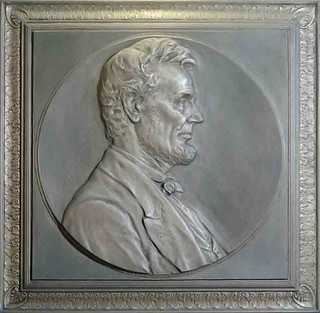
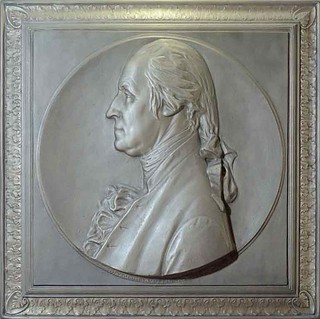
Undated Medallic Items:
n.d. Burritt (Elihu) Plaque . . . . . . . . . . . . . . .
Photo: Smithsonian Photo Archives Image . . . . J0123303
n.d. La Pastidiosa Dual Decorative Panels . . . . . . . . . . .Hahlo 150
n.d. Our Mental Dance Plaquette . . . . . . . . . . . . .
n.d. United States Seal Hold It High (Relief) . . . . . . .Smedley 7, 8 Undated Sculpture
n.d. Adam and Eve Terrocota. . . . . . . . . . . . . . . .
Auction: Nancy France 19 February 1984 (5,000 francs)
n.d. Dusk Wall Fountain Sculpture . . . . . . . . . . . .
n.d. Earth and Water Sculpture. . . . . . . . . . . . . . . . . .
Photo: Smithsonian Photo Archives Image . . . . J0123359
n.d. Elizabeth Bust Sculpture . . . . . . . . . . . . . . . . . . . . . . . .
Exhibited: National Sculpture Soc AE8 (1923) no. . .326
n.d. Family Tomb Plaster Model. . . . . . . . . . . . . . . . . .Hahlo 143
n.d. Faun Statue. . . . . . . . . . . . . . . . . . . . .
Exhibited: Art Institute of Chicago AE2 (1912) no. . ..337
n.d. Female Dancer Statue. . . . . . . . .
n.d. Hutton (Frederick Remsen) Sculpture. . . . . . . . . .
Photo: Smithsonian Photo Archives Image . . . . J0123288
n.d. Hygenel Sculpture [possible 1912 for International Congress that year]. . . . . . . . . . . . . . . . . . . . . . . . Photo: Smithsonian Photo Archives Image . . . . J0123283
n.d. Male and Female Figures (unknown name; colossal size) Archives: Inventory of Am Sculpture . . . . IAS76009045
n.d. Male Iceskater Statue . . . . . . . . . . . . . . . . . . . . . . . .
n.d. Man [Lapith] Battling Centaur Statue. . . . . . . . . . . .
n.d. Music Statue . . . . . . . . . . . . . . . . . . . . . . . . . . . . .Hahlo 142
n.d. Nature the Consoler Sculpture. . . . . . . . . . . .
Exhibited: Art Institute of Chicago AE2 (1916) no. . . 425
Exhibited: San Fran Pan-Pacific Expo (1915) no. . . .3131
Photo: Smithsonian Photo Archives Image . . . S0000322
n.d. Return To Nature Sculpture (carved in Seravezza marble). . . . . . . . . . . . . . . . . . . .. . . . . . . . . . .. Hahlo 147
n.d. Singing Statue . . . . . . . . . . . . . . . . . . .
n.d. Timidity Sculpture (also called Expertancy [!] Statue, and
Venus Statue and exhibited under these names) . . . . . . . .
Exhibited: Art Institute of Chicago AE2 (1912) no. . .338
Photo: Smithsonian Photo Archives Image . . . S0000324
n.d. Water Lilly Sculpture (also called The Lilly). . . . . . . . . .330
To read the earlier E-Sylum article, see:
SCULPTURES BY U.S. COIN DESIGNERS
(https://www.coinbooks.org/v23/esylum_v23n35a20.html)
NOTES FROM E-SYLUM READERS: SEPTEMBER 6, 2020 : Brenner's Three-Dimensional Sculptures
(https://www.coinbooks.org/v23/esylum_v23n36a12.html)

VOCABULARY TERM: MORTUARY MEDAL
Dick Johnson submitted this entry from his Encyclopedia of Coin and Medal Terminology. Thanks. -Editor
Mortuary Medal. A medallic item issued on the occasion of the death of the person portrayed or indicated on the item. Also called Death Medal or Funeral Medal. Albert Frey states that the term mortuary was also applied to coins issued by one monarch shortly after the death and in honor of his predecessor. The larger class of these items are medals, however, and could be applied to any medallic item mentioning the death or funeral of a person.
Reference:
NE12 {1917} Frey, p 155.
Looking for the meaning of a numismatic word, or the description of a term? Try the Newman Numismatic Portal's Numismatic Dictionary at: https://nnp.wustl.edu/library/dictionary
Or if you would like a printed copy of the complete Encyclopedia, it is available. There are 1,854 terms, on 678 pages, in The Encyclopedia of Coin and Medal Technology. Even running two a week would require more than 19 years to publish them all. If you would like an advance draft of this vital reference work it may be obtained from the author for your check of $50 sent postpaid. Dick Johnson, 139 Thompson Drive, Torrington, CT 06790.

FR. ATHANASIUS KIRCHER, S. J. (1602-1680)
John Lupia submitted the following information from the online draft of his book of numismatic biographies for this week's installment of his series. Thanks! As always, this is an excerpt with the full article and bibliography available online. This week's subject is early numismatic author Athanasius Kircher. -Editor
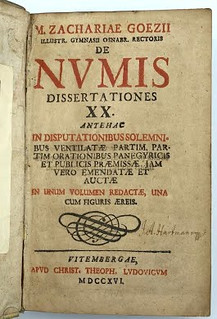 Fr. Athanasius Kircher, S. J. (1602-1680), was born on May 2, 1602, at Geisa (now Thuringia), Germany, son of Johannes Kircher, counselor of the prince-abbé Balthasar de Fulda.
Fr. Athanasius Kircher, S. J. (1602-1680), was born on May 2, 1602, at Geisa (now Thuringia), Germany, son of Johannes Kircher, counselor of the prince-abbé Balthasar de Fulda.
At a young age he exhibited a fascination and keen interest in geology.
From 1614-1618, he was educated at Fulda in the Jesuit College.
From 1618-1622, he studied in the Jesuit novitiate.
In 1628, he was ordained a priest in the Society of Jesus.
Among the many fields of endeavor of Fr. Athanasius Kircher, S. J., one field of activity was as an early epigrapher, i.e., a scholar in the first half of the seventeenth century who attempted to work out the puzzle of messages of unknown ancient languages found in various inscriptions in various media like stones, medals, and coins based on clues of site origin where they were found and/or context. The lack of a pre-existing infrastructure containing a wealth of data to draw from in his day explains his obvious failures and hardly detract from his many accomplishments that have contributed to a fuller picture of subjects in several disciplines. Consequently, it was only natural that he would have misinterpreted some inscriptions like the one found on an ancient Cyprian scarab which he mistook in his Prodromos Coptus (Rome, 1636) as Coptic because of its scarab design having been associated with Egyptian art and archaeology by earlier writers like Ulisse Aldrovandi.
His later volumes on Hieroglyphs from 1650-1654 were a similar attempt which demonstrates an intellectual with a flair for problem solving working in a vacuum attempting to solve the riddle of the ancient hieratic pictograms. Its quite O.K. to have failed at something so original and monumental a task over 150 years before Bouchard's discovery of the Rosetta Stone in 1799 that took more than two decades later to be deciphered by J-F Champollion in 1822. It is very probable that Kircher's errors helped to guide the way for Champollion.
Fr. Kircher wrote mainly on Roman coins. In the field of numismatic studies their is paucity of any work and to date the best reference is found in John Edward Fletcher, A Study of the Life and Works of Athanasius Kircher, ‘Germanus Incredibilis’. (Brill, 2011) : 182
Fletcher refers to the published letters of Zacharias Goetz (1662-1716), that pertain to Fr. Kircher's numismatic research. Additionally to the work of Francisco Perez Bayer (1711-1794), De nummis Hebraeo-Samaritanis, which gives two references to Kircher.
However, it should be noted that a bibliographic citation to the numismatic related writings of Fr. Kircher was published in Lipsius', Bibliotheca Numuaria, page 209 with the entry - Kircheri (Athan.) Latium, i. e., nova et parallela Latii novi et veteris Descriptio, qua quaecumque vel natura, vel veterum Romanorum ingenium admiranda efficit. . . (Amsterdam, 1671), containing maps and plates, citing Numismata Sepulchrorum; Fortuna in numis.; Numismata Centronii. Lipsius also cites a second book, Principia Christiani archetypon politicum, etc. (Amsterdam, 1672).
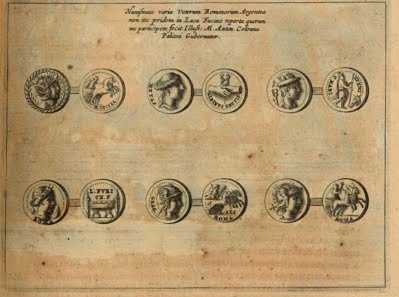
Plate of six Roman coins from Abruzzi region at Lake Fucino in Chapter VIII, Oppidum Sancti Viti, in Kircher's, Latium, i. e., nova et parallela . . . (Amsterdam, 1671), page 189
From this paucity or dearth of any serious research on the numismatic works of Fr. Kircher a doctoral dissertation or two would certainly contribute to a more detailed portrait.
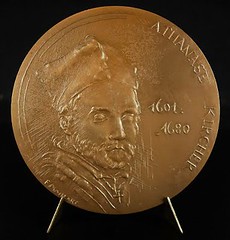
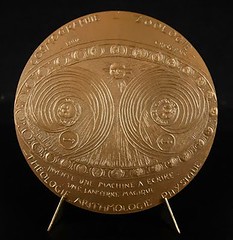
The modern Athanasius Kircher bronze medal was designed in 1976 for his tricentennial by sculptress Frédérique Maillart.
To read the complete article, see:
KIRCHER, S. J., ATHANASIUS
(http://www.numismaticmall.com/numismaticmall-com/kircher-s-j-athanasius)
We have at least one other reference to Athanasius Kircher in The E-Sylum and surprisingly, it's not about a book. The reverse of the medal pictured above seems to show a labyrinth, which is also the subject of a 2016 Cook Island coin design. Since it's non-numismatic I'll leave the background on Kircher's Labyrinth as an exercise for the reader. -Editor
"The reverse depicts the Egyptian Labyrinth of Athanasius Kircher and features a playable micro- labyrinth inlay in the centre. Engraved are the inscriptions MILESTONES OF MANKIND, EGYPTIAN LABYRINTH, and the year of issue."
To read the earlier E-Sylum article, see:
SOME RECENT COIN DESIGNS: MARCH 27, 2016 : 2016 Cook Islands Egyptian Labyrinth
(https://www.coinbooks.org/esylum_v19n13a28.html)
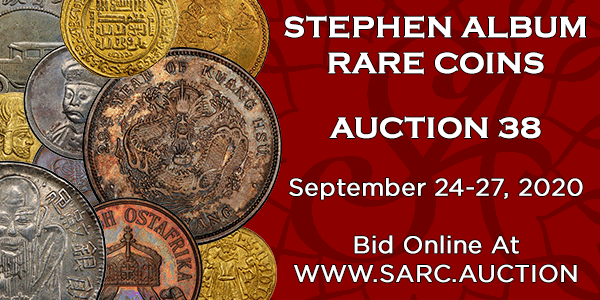
HARVEY STACK'S NUMISMATIC FAMILY, PART 78
The latest article in Harvey Stack's blog series continues the discussion of 1979 auctions, including deaccession sales from James Madison University and the Charlotte Mint Museum, through the first Apostrophe sale, Auction '79. Thanks, Harvey. -Editor
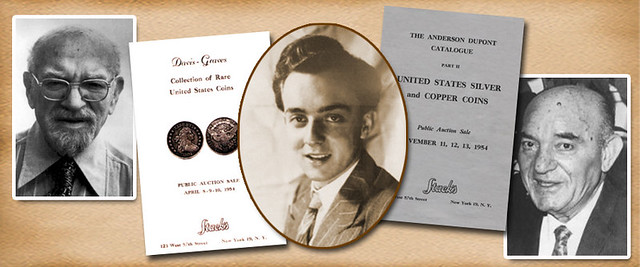
Stack's 1979 auction season continued with a celebrated collection of ancient Roman and Greek coins. This sale included 1,499 lots gathered by Dr. John A. Sawhill that had been given to James Madison University. Dr. Sawhill was a teacher of ancient history who collected pieces that represented his specialty. Central to the offering was 256 coins that the doctor had purchased from our Massachusetts Historical Society sale in 1971. Many of the coins from the Sawhill Collection found their way into major collections.
In March 1979, Stack's was selected by the Charlotte Mint Museum to sell their duplicate gold coins, those from the original collection as well as others that had been given to them. These were sold in order to refurbish and re-build their museum with newer and more educational exhibits. This was typical of many institutions that exhibited the coins that were appropriate and sold others so that they had funds to attract visitors and supporters and increase educational programs. This sale featured about 800 lots and attracted many collectors of Southern Mint gold.
In May Stack's was again the Official Auctioneer for the Metropolitan New York Numismatic Convention, as we were for many years. The sale presented 1,123 lots of classic United States coins in all metals, as well as paper money and ancient and world gold, silver and copper issues. As was preferred for these convention auctions, the sale offered something for everyone and attracted hundreds of active bidders.
Our June 1979 public auction offered gold coins of the United States, with 848 lots of choice and rare gold coins as well as an addendum that featured some early Proof sets issued prior to 1915, rare patterns, and rolls of coins The highlight of the sale was an extremely rare Saint-Gaudens MCMVII Ultra High Relief $20, an item almost never offered at public action. The audience applauded when it sold for $220,000. Also of note were 1920-S and 1930-S eagles and a nearly complete set of double eagles, including a very choice 1854-O, as well as examples of the 1856-O, 1881, 1882, 1883, 1884, and 1885 in Proof. Saint-Gaudens double eagles featured almost all the rare date mintmarks from the 1920s through the 1930s. The quality of the pieces was exceptional, as the consignor had been a true connoisseur who was willing to wait for the coins that satisfied him.
In the summer, Stack's was proud to partner with other important numismatic dealers in a novel auction experience. As noted in a previous article in this series, Stack's and others had become frustrated with the process that they were required to go through to present the annual ANA Convention sale. Instead, four leading firms – Stack's, RARCOA, Paramount, and Superior joined together in the "Apostrophe" auctions, the first of which, Auction '79 was held in Bridgeton, Missouri, in July before the ANA Convention, scheduled that year for St. Louis.
Each company was to consign to the sale 500 lots, hopefully to include rarities and high grade coins. Each company would catalog their own lots and send them to David Akers to organize, photograph and prepare them for printing. The companies would submit their mailing lists to an independent mailing house, who would compare the names and mail a single copy of the catalog to each potential buyer. The sale was very popular and there turned out to be almost 1,000 active bidders.
Clients would send in bid sheets, they would be given a bidder number and their bids would be entered under the name of whichever company the clients wished to have represent them. It was careful and confidential work, as many wanted their favorite company to bid for them. As all four firms had a great deal of experience, this was accomplished with no difficulty.
The sale presented a large selection of very choice and rare coins, from the colonial period, through standard coinage, copper to $20 gold, as well as territorial issues. Original pre-1915 Proof sets were also offered. The viewing room, two days before the sale was crowded and many waited in line to view the lots. The auction was held in four sessions over two days, with the auction companies providing food between the sessions. It was a great numismatic event, with a very friendly crowd of dealers and collectors that were attracted by the quality of the lots being sold. The joint offering was so successful that the dealers involved agreed to have another combined summer auction in 1980.
To read the complete article, see:
Harvey Stack Remembers: Growing up in a Numismatic Family, Part 78
(https://www.stacksbowers.com/News/Pages/Blogs.aspx?ArticleID=harvey-stack-remembers-part-78)
To read the earlier E-Sylum article, see:
HARVEY STACK'S NUMISMATIC FAMILY, PART 77
(https://www.coinbooks.org/v23/esylum_v23n35a18.html)
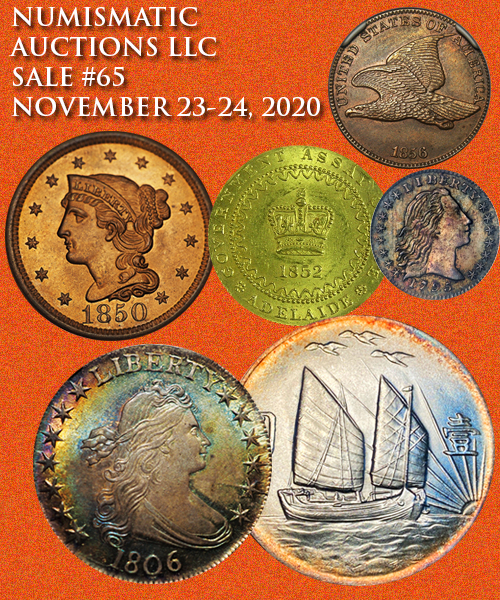
DONALD PARTRICK AND THE FREDERICK TAYLOR SALE
Jeff Rock submitted these recollections of Donald Partrick and the Frederick Taylor sale. Thanks! -Editor
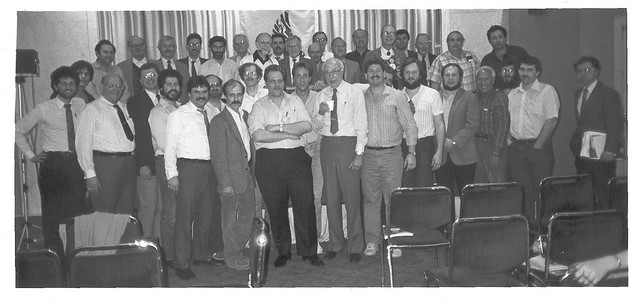
I'm slowly catching up on my E-Sylum reading and noticed in the August 23rd issue some comments on the late Don Partrick. As someone who went to nearly every major sale of colonial coins in the 80s and 90s, I often saw Don in action. Well, in action during the earlier years and in inaction in the later, as Alan Weinberg detailed. Thinking that people were running him up because it was HIM that was bidding, he started bidding through others, mostly (but not exclusively) Jon Hanson. But the street went both ways. Don quickly figured out who the most knowledgeable bidders were in each series and he used that information to his own advantage. If one of them was bidding on something, then that lot was special somehow and he paid more attention to it - often buying duplicates in the process, but convinced he made good buys (and time proved him to be correct).
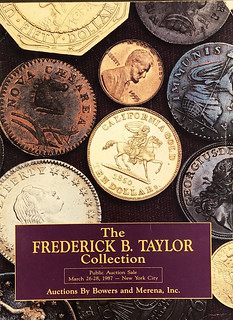 At the 1987 sale of the famous Frederick Taylor collection (held at the World Trade Center in Manhattan), Don was in his element - and he managed to strike fear into most of us in attendance. He was never a chatty person, save to the Bowers & Merena people and a few major dealers. A group of us, mainly interested in the Connecticut copper series, were warily chatting before the sale, trying to get info on what the others were bidding on while pretending to be disinterested in the lots we wanted the most. Don, for the first time I remember, walked straight up to our group and joined the conversation - though he joined it with something of a bombshell. He said "you variety collectors have been having all the fun for far too long" and then he smiled and walked over to his place at the front of the room. If there was a thought bubble over our heads it would have literally read "Oh, #%**!" Don steamrolled through the sale - not buying everything, but buying nearly everything choice or rare, and pretty much everything that was both.
At the 1987 sale of the famous Frederick Taylor collection (held at the World Trade Center in Manhattan), Don was in his element - and he managed to strike fear into most of us in attendance. He was never a chatty person, save to the Bowers & Merena people and a few major dealers. A group of us, mainly interested in the Connecticut copper series, were warily chatting before the sale, trying to get info on what the others were bidding on while pretending to be disinterested in the lots we wanted the most. Don, for the first time I remember, walked straight up to our group and joined the conversation - though he joined it with something of a bombshell. He said "you variety collectors have been having all the fun for far too long" and then he smiled and walked over to his place at the front of the room. If there was a thought bubble over our heads it would have literally read "Oh, #%**!" Don steamrolled through the sale - not buying everything, but buying nearly everything choice or rare, and pretty much everything that was both.
This was, sadly for us collectors, a trend that would continue for the next 20 years. He could be beat, but it would mean paying significantly more than retail. He sometimes missed a coin that he needed or that was a better grade, and he sometimes made mistakes - as we all do in such situations. But he was, without a doubt, the most formidable competitor of the era for colonial and early American coinage. More than once I saw his (or his agent's) hand go up and other bidders just put their hand down in anticipation of the inevitable - even when they had many bids left to reach their own personal limit.
Through dozens of sales I never knew Don to go to dinner or have a drink with any of his fellow collectors afterwards - or to engage in the horse-trading that went on before any auction, offering to lay off something that another collector really wanted. He didn't need to, he was in a class of his own and he knew it. He didn't care about the intricacies of die varieties or assemble reams of Condition Census and rarity information. He was, at heart, a checklist collector - but oh, what a checklist. He wanted every variety of everything, and if it happened to be the finest known, even better. His collection is a testament to what time, money and passion can do - it may be equaled, but it will likely prove impossible to better.
Above is a picture from that Taylor sale - hard to believe it was over 30 years ago. I see a very young me, somehow smack dab in the center behind John Ford, surrounded by friends, many of whom are no longer with us. Don is standing off to the right, in a position he probably appreciated: away from center stage, but smiling broadly, knowing that he was going home that night with everything he wanted from that sale.
More great numismatic history. Other E-Sylum readers were there - tell us your stories about the sale, and help put names to the faces in the photo. -Editor
To read the earlier E-Sylum article, see:
MORE ON DONALD GROVES PARTRICK
(https://www.coinbooks.org/v23/esylum_v23n34a11.html)
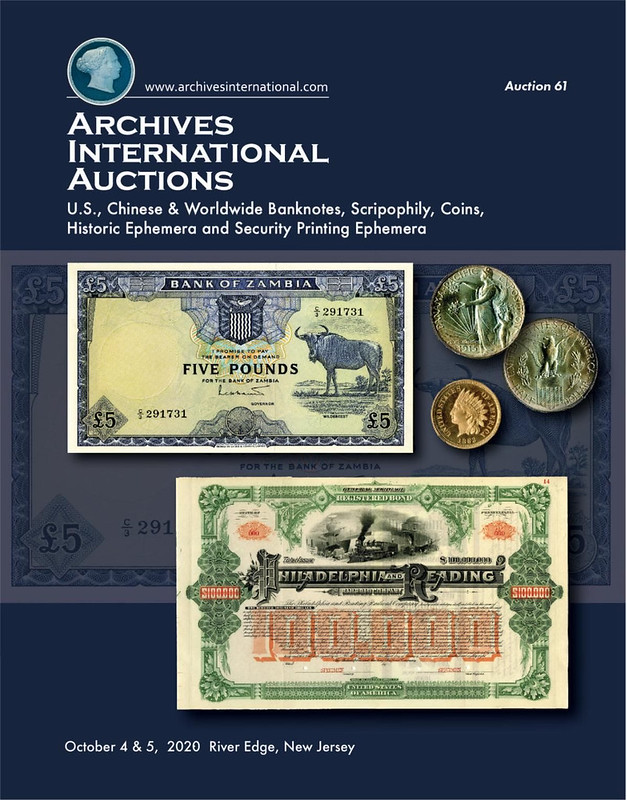
SEPTEMBER, 2020 GOLDBERG SALE SELECTIONS
Here are some lots that caught my eye in the Ira & Larry Goldberg Auctioneers September 2020 sale. -Editor
Lot 2010: Syracuse. Dionysios I. Silver Decadrachm
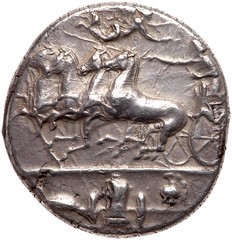
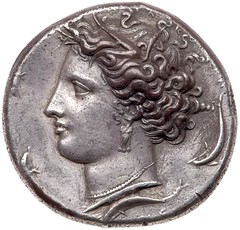
Sicily, Syracuse. Dionysios I. Silver Decadrachm, 405-367 BC. Ca. 405-400 BC. Reverse die signed by the master engraver Euainetos. Charioteer driving galloping quadriga left, holding kentron and reins; above, Nike flying right, crowning charioteer with wreath; below heavy exergual line, military harness, shield, greaves, cuirass, and Attic helmet, all before a horizontal spear. Reverse: Wreathed head of Arethusa left, wearing triple-pendant earring and necklace, surrounded by four dolphins; below neck truncation [EY-AIN]E. Gallatin dies R.IV/C.XI; SNG ANS 366 (same obv. die). Boldly struck in high relief. Probably cleaned long ago, a thin layer of horned silver (silver oxide) has been expertly removed, showing the details of Arethusa's hairline engraved by the master Euainetos, now a pleasing light grey. About Extremely Fine. Estimated Value $15,000 - UP
Amongst the most famous of all ancient Greek coins, the decadrachms of Syracuse were struck to finance the military ambitions of the tyrant, Dionysios I, who made Syracuse the most powerful of the western Greek city-states. The master artists Kimon and Euainetos worked at the mint, and both sometimes signed their dies. However, the styles are sufficiently distinct that even on unsigned dies the hand of the engraver can easily be determined. Euainetos's coins were especially regarded in ancient times even as they are today, and served as inspiration for the coinage of a number of other cities throughout the Greek world.
Ex NFA XXXII (June 10, 1993, lot 15).
Love the galloping quadriga. -Editor
To read the complete lot description, see:
Lot 2010 of 2777:
Sicily, Syracuse. Dionysios I. Silver Decadrachm, 405-367 BC About EF
(https://www.goldbergcoins.com/view-auctions/catalog/id/73/lot/151260/)
Lot 2013: Macedonia, Akanthos. Silver Tetradrachm
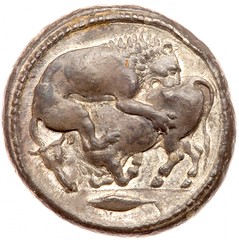
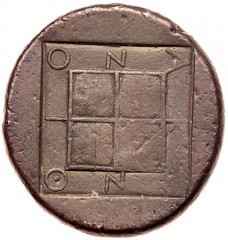
Macedonia, Akanthos. Silver Tetradrachm (17.19 g), ca. 470-430 BC. Lion right attacking bull standing left; in exergue, fish left. Reverse: AK-ANT-IO-N within square border surrounding quadripartite incuse square. Desneux 97 (D94/R87); AMNG III/2, 21; HGC 3, 385. Fantastic style and beautiful deep grey find toning.
This tetradrachm was struck at Akanthos in the decades between the repulse of the Persian invasion of Greece (480-479 BC) and the outbreak of the Peloponnesian War (431-404 BC), a period in which the Athenians were very active in establishing influence over the cities of coastal Macedonian and Thrace through membership in the Delian League. Akanthos had become a member of the League by 450 BC, but the city seems to have tired of Athenian domination in the early years of the Peloponnesian War. In 424 BC, the Akanthians secretly voted to secede from the Delean League and supported the Spartan general Brasidas and the Chalkidian League against Athenian interests in Macedonia. The use of the Attic weight standard (ca. 17.2 g) for this coin reflects Athenian influence at the time of its production. After 424 BC, Akanthian coins normally employ a lighter Chalkidian standard (ca. 14.4 g). While not so common on Greek coins, the obverse motif of a lion attacking a bull enjoyed great popularity throughout the ancient Near East and may have been adopted by Akanthos through its exposure to Persian culture. The Akanthians are known to have been on friendly terms with the Persians by 480 BC, when they welcomed Xerxes I and his army. The reverse quadripartite incuse design surrounded by a legend was widely used on contemporary coins struck in Macedonia and Thrace. It occurs on issues of the Macedonian king Alexander I as well as on coins of the Bisaltai and Edones and cities like Abdera and Mende.
Ex Tareq Hani Collection.
That's a lot of bull! -Editor
To read the complete lot description, see:
Lot 2013 of 2777:
Macedonia, Akanthos. Silver Tetradrachm (17.19 g), ca. 470-430 BC EF
(https://www.goldbergcoins.com/view-auctions/catalog/id/73/lot/153049/)
Lot 2078: Cyprus, Amathos Silver Stater
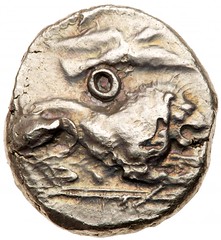
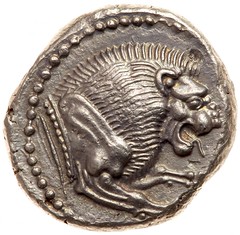
Cyprus, Amathos. Uncertain king. Silver Stater (11.37 g), ca. 450-435 BC. Lion crouching right; above, eagle flying right; between lion and eagle, large O (added to the die); in exergue, Cypriot 'mo' (very faint). Reverse: Forepart of lion right, with mouth agape. Amandry 126, 1 (same obv. die, but with 'O' added); Traité II 1262 and pl. CXXXII, 17; BMC 3 and pl. XVIII, 3 (same); Tziambazis 2 (same). Extremely Rare. Possibly the finest of only a few examples known.
This rare stater 'illustrates the variety of cultural influences at work at Amathos and Cyprus in general in the mid-fifth century BC. The lions here appear as symbols of royal power common to Greek, Phoenician, and Persian traditions. The recumbent lion recalls archaic issues of Ionian Miletos, yet the treatment of the ribs and mane suggest Phoenician and Persian influence. At the same time, the inscription abbreviating the name of the city is written in neither Greek nor a Semitic script, but rather using the Cypriot syllabary, a native writing system derived from the Linear A script of the Minoan Bronze Age.
Ex Tareq Hani Collection.
Great lion. -Editor
To read the complete lot description, see:
Lot 2078 of 2777:
Cyprus, Amathos. Uncertain king. Silver Stater (11.37 g), ca. 450-435 BC EF
(https://www.goldbergcoins.com/view-auctions/catalog/id/73/lot/153046/)
Lot 2092: Seleukid Kingdom Silver Tetradrachm
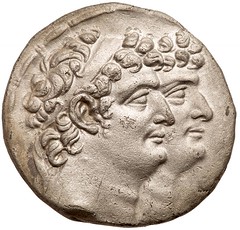
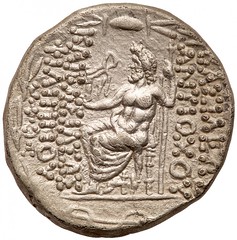
Seleukid Kingdom. Antiochos XI Epiphanes Philadelphos and Philip I Philadelphos. Silver Tetradrachm (15.8 g), circa 94-93 BC. Uncertain mint 127, in Cilicia (probably at Tarsos). Jugate and diademed heads of Antiochos XI and Philip I right. Reverse: BASI?EOS ANTIO?OY KAI BASI?EOS FI?I??OY, Zeus enthroned left, holding Nike and scepter; in outer left field, monogram above A; below throne, F; all within laurel wreath. SC 2438 (same obv. die); HGC 9, 1297 (same obv. die). Extremely Rare and of the utmost importance. One of just three known examples and the only example with clear controls.
In the early first century BC, the Seleukid Empire was dying. Not a "go gentle into that good night sort of death," but a loud crashing doom, attended by flame and the spilling of blood. In 94 BC, Seleukos VI Epiphanes had been driven out of Syria by his uncle, Antiochos X Eusebes, and began to regroup at Mopsos, his base in Cilicia. Unfortunately, the harsh measures he used to raise money for a new round of warfare against Antiochos X turned the Mopsians against him and Seleucus VI was burned alive in his palace. When news of this shocking development reached his brothers, Antiochus XI and Philip I, they marched out of their own Cilician base, possibly at Tarsos, and sacked Mopsos in revenge.
Once the Mopsians had been dealt with, Antiochos XI and Philip I then began to plan the fall of their uncle and the recapture of Antioch. While Philip I remained in Cilicia, in 94/3 BC, Antiochos XI entered Syria and briefly expelled Antiochos X from Antioch. Alas, the latter soon returned with a new army and Antiochos XI was drowned during a battle on the banks of the Orontes River. Philip I only managed to seize the Syrian capital after the death of his uncle and the capture of his third (and rival) brother, Demetrios III Eukairos, by the Parthians in ca. 88 BC, but by then, the Seleukid Empire consisted of very little else but the city of Antioch and its surrounding territory. Under Philip I, the once-great creation of Seleukos I crawled into its coffin. All that remained was to wait for the Romans and the nails.
Wow! Amazing, powerful portraits. -Editor
To read the complete lot description, see:
Seleukid Kingdom. Antiochos XI Epiphanes Philadelphos and Philip I Philadelphos. Silver Tetradrachm (15.8 g), circa 94-93 BC
(https://www.goldbergcoins.com/view-auctions/catalog/id/73/lot/152795/)
Lot 1738 George II 5 Guineas
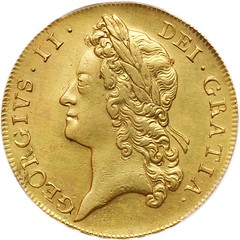
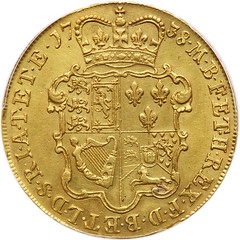
Great Britain. 5 Guineas, 1738. S.3663A; Fr-332; KM-571.1. George II, 1727-1760. DVODECIMO edge. Young laureate head left. Reverse; Crowned shield of arms. PCGS graded About Uncirculated, Detail (Repaired). Estimated Value $5,000 - 7,000
To read the complete lot description, see:
Lot 2387 of 2777:
Great Britain. 5 Guineas, 1738 PCGS About Un
(https://www.goldbergcoins.com/view-auctions/catalog/id/73/lot/151703/)
Lot 2506: 1676 Charles II Crown
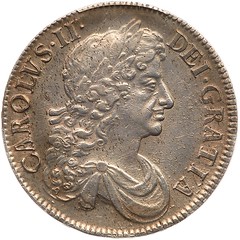
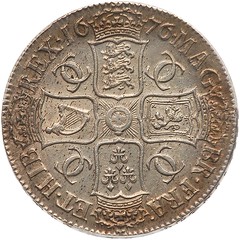
Great Britain. Crown, 1676. S.3358; ESC-51; Dav-3776. Charles II. 3rd bust 1676. Obverse portrait of king by John Roettier (1631-1700). Reverse, crowned cruciform shields with interlinked C s in angles. Edge reads VICESIMO OCTAVO in raised lettering. Nearly uncirculated for issue, but probably struck from slightly worn dies.
After the return of the monarchy in 1660, Charles II welcomed the changes in the production of coinage. In the period 1662-3 the old fashioned hand hammering procedure was finally superceded by the use of the machinery of Pierre Blondeau. John and Joseph Roettier engraved dies for the larger coins with a raised edge inscription and this virtually ended the criminal practice of clipping small pieces of precious metal from the edge of the coins. Charles II's reign was marked by some religious discord and certain foreign wars and costly skirmishes, but generally, Charles's position was secure, and he was careful to be more pragmatic in his dealings than his father, the ill-fated Charles I. Charles II was a great patron of the arts and science and he was popular among the people of England.
To read the complete lot description, see:
Lot 2506 of 2777:
Great Britain. Crown, 1676 PCGS AU55
(https://www.goldbergcoins.com/view-auctions/catalog/id/73/lot/149806/)
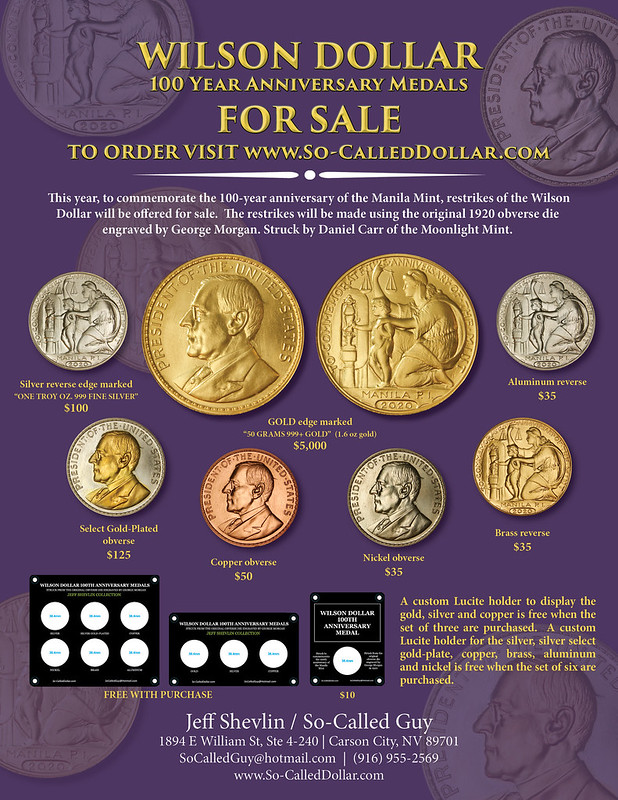
E PLURIBUS UNUM COLLECTION SALE, PART 2
These are good times for collectors of Colonial and early American coins and tokens, with wide and deep collections coming to the market soon. Here's a teaser article from Stack's Bowers summarizing the second part of the E Pluribus Unum Collection. -Editor

Did you know The E Pluribus Unum Collection, Part 2: Colonial Coins and Washingtoniana will be featured in the Stack's Bowers Galleries November 11-13, 2020 Auction?
Built over the course of more than half a century, the E Pluribus Unum Collection is replete with coins and medals of superb rarity and quality, many with significant pedigrees, some of which date to the 19th century. Sales from the collection commenced in our November 2019 Baltimore Auction with the record-setting auction of the best collection of New Jersey coppers sold since 2003. Building upon that momentum, Part 2 of the collection numbers nearly 500 pieces and focuses on a variety of 17th and 18th century colonial coin types, along with Washington coins, medals and tokens. Notable sectors include American Plantations tokens, St. Patrick coinage, Wood's Hibernia and Rosa Americana coinages, Voce Populis, Vermont coppers, Auctori Plebis coppers, Mott tokens, Castorland medals, and Franco-American jetons. Of special note are nearly 40 Machin's Mills halfpence by die marriage, more than 60 Connecticut coppers, and over 200 pieces of Washingtoniana. Of particular interest to specialists in the colonial series, the sale features dozens of numismatic delicacies like multiple strikes and brockages, in addition to several rare and high quality overstrikes.
This outstanding collection will cross the block November 11-13, 2020. Contact us today to request your copy of the catalog. Further details on the auction location will be released in the coming weeks.
To read the complete article, see:
The E Pluribus Unum Collection, Part 2: Colonial Coins and Washingtoniana
(https://www.stacksbowers.com/News/Pages/Blogs.aspx?ArticleID=e-pluribus-unum-collection-part-2)

NGC DONALD G. PARTRICK COLLECTION IMAGE GALLERY
This NGC Press Release announces the image gallery of the Donald G. Partrick Collection of Colonial and early US coins. I've included a few random coin images. Some amazing material including multiple Higley coppers! -Editor
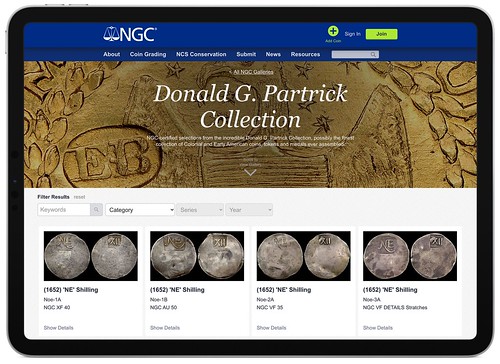
Numismatic Guaranty Corporation® (NGC®) has updated its image gallery of the Donald G. Partrick Collection with more than 1,000 additional coins, tokens and medals, giving numismatists the opportunity to explore this unparalleled collection of Colonial and early US coins. The Partrick Collection, entirely certified by NGC, includes some of the greatest rarities in all of numismatics, including two Brasher Doubloons, the first gold coins struck in the newly independent United States.
NGC’s Donald G. Partrick Collection image gallery is located at NGCcoin.com/Partrick.
NGC has also released a video showing the Brasher Doubloons and other highlights in a format that allows viewers to better appreciate the rarity and quality of these extraordinary coins. To view the video, go to YouTube.com/NGCcoinVideos.
"I feel incredibly fortunate to have been able to examine these rare and historic coins up close," said Mark Salzberg, NGC Chairman and Grading Finalizer. "I hope that this image gallery and video give other coin collectors the same feeling of awe and excitement that I had when I graded these phenomenal rarities."
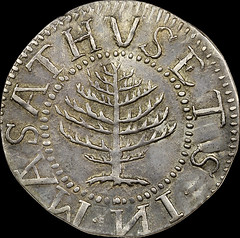
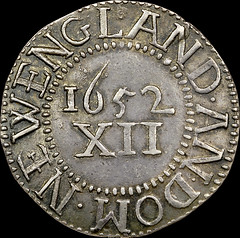
Pine Tree Shilling Noe-3
The first 350 coins from the Partrick Collection were sold in 2015, realizing nearly $26 million. The remainder of the collection will be offered over the next year by Heritage Auctions, starting with a sale of Connecticut Coppers in October, closing on November 1. For the latest updates on the Heritage auctions, please regularly visit: HA.com/Partrick.
NGC's Partrick Collection image gallery now contains stunning, high-resolution images of more than 1,400 coins searchable by type and keyword. The Patterns category, for example, features 12 incredibly rare patterns (or proposed coins) with a date of 1792, the year that Congress authorized the US Mint and US coins. Viewing them together provides an incomparable view into the young nation’s earliest attempts at a national coinage and the ideals and themes that it represented.
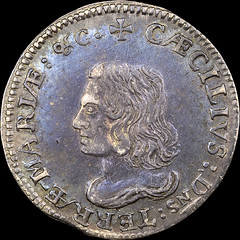
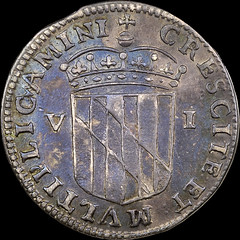
Lord Baltimore Sixpence
This group of a dozen cents, dismes and quarters realized an incredible $10.5 million combined at the first Partrick Collection sale in 2015. Among these is a 1792 Judd-4 Birch Pattern Cent that realized $2,585,000, the highest result from the Partrick Collection to date and one of the highest prices ever paid for a coin. The group also includes a 1792 Copper Quarter Pattern that realized $2,232,500 and a 1792 Copper Disme Pattern that realized $1,057,500.
The gallery also shows:
- a comprehensive sampling of the diverse coinage used at various times and places in Colonial America, including over 100 Massachusetts Colonials such as Willow Tree, Oak Tree and Pine Tree coins
- 15 1776 Continental Dollars, an incredible group of brass, pewter and silver examples of this important series (Two of these each realized more than $1.5 million in the initial Partrick sale in 2015.)
- more than 500 Connecticut Coppers from the 1780s, including more than 300 varieties of about 360 that are known
- nearly 200 New Jersey Coppers, 100 Vermont Coppers and more than 60 Massachusetts Half Cents and Cents from the 1780s
- over 270 Half Cents, from the federal series' inception in 1793 until its conclusion in 1857, including a rich array of the die marriages that make the denomination so challenging for specialists.
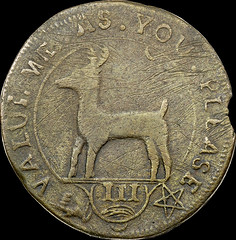
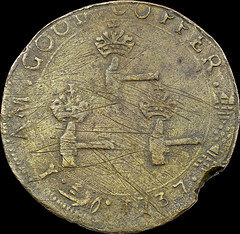
1727 Higley Threepence Three Hammers
View these coins and more from the Partrick Collection at NGCcoin.com/Partrick.
As the Partrick Collection is offered for sale over the next year, make sure to check for additional updates at NGCcoin.com/news and subscribe at NGCcoin.com/connect.
For the latest updates on the Heritage auctions, please regularly visit HA.com/Partrick.

NUMISMATIC AUCTIONS LLC SALE 65
Steve Davis of Numismatic Auctions LLC passed along this announcement of his November 2020 sale #65. Some GREAT material here; we'll look forward to more details. -Editor
Announces Auction Sale #65, November 23-24, 2020
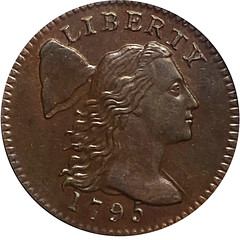
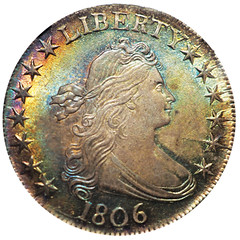
1795 Large Cent; 1806 Bust Half O-109
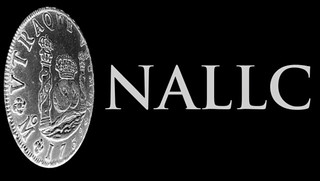 Numismatic Auctions L.L.C. proudly presents our 65th catalog sale of nearly 3000 lots,
which will take place Monday and Tuesday, November 23-24, 2020, subject to possible
change due to Covid-19 developments. This auction contains several terrific buying
opportunities for the collector community such as selections from the collections of George
Harrison III and Jack Lavis along with many other important consignments. The auction
features rare U.S. Coins and Currency, including previously unknown original Laura Gardin
Fraser and Anthony DeFrancisci Plasters & related items for the Washington Quarter and
Peace Dollar. The sale is also highlighted by Civil War Tokens, rare Lincoln material,
Canadian & World Coins, Gold, Tokens, Medals and Foreign Paper Money.
Numismatic Auctions L.L.C. proudly presents our 65th catalog sale of nearly 3000 lots,
which will take place Monday and Tuesday, November 23-24, 2020, subject to possible
change due to Covid-19 developments. This auction contains several terrific buying
opportunities for the collector community such as selections from the collections of George
Harrison III and Jack Lavis along with many other important consignments. The auction
features rare U.S. Coins and Currency, including previously unknown original Laura Gardin
Fraser and Anthony DeFrancisci Plasters & related items for the Washington Quarter and
Peace Dollar. The sale is also highlighted by Civil War Tokens, rare Lincoln material,
Canadian & World Coins, Gold, Tokens, Medals and Foreign Paper Money.
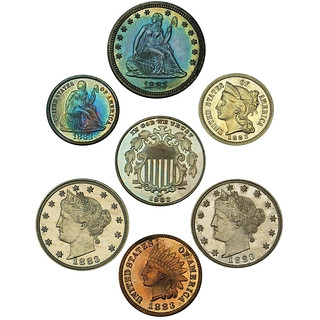
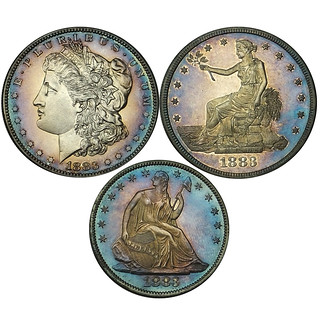
Original 1883 Proof Set Cent to Trade Dollar
The United States Coin and Currency section is comprised of over 1500 lots of quality Coinage and Paper Money from Colonial issues to Gold, Commemoratives and beyond in addition to a spectacular specialized listing of Early Copper Coinage, Capped Bust Dimes, Registry Barber Coinage, Michigan Obsolete Banknote Collection, Rare Large and Small Size Currency, Nationals, Fractionals, C.S.A. and much more. The Canadian and World material also nears another 1500 lots, featuring approximately 500 lots of Gold coins alone, along with Ancient to Modern World Coins from Minors to Taler and Crown size examples from around the globe including rare Chinese, German, Great Britain, European, Latin American, Philippines and a vast number of British and Commonwealth Nations issues as well as an amazing selection of World Currency from three major collections. Certified rarities as well as raw coins and notes of opportunity abound in this auction which affords something for virtually everyone!
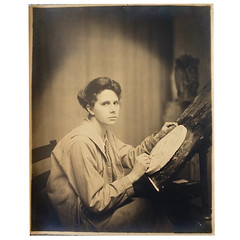
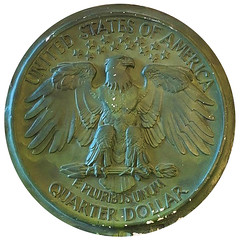
Laura Gardin Fraser and her Unadopted Washington Quarter Reverse Plaster
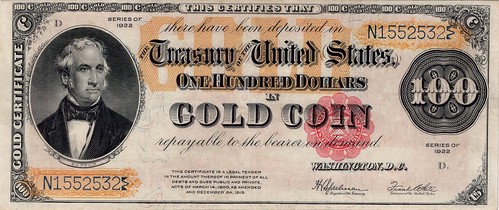
1922 $100 Gold Certificate
Please stay tuned at www.numismaticauctionsllc.com for more information regarding this upcoming November 23-24, 2020 sale event! The catalog for Auction Sale #65 will be able to be viewed or downloaded digitally at www.numismaticauctionsllc.com once it is completed and published copies can be requested in advance by contacting Steven Davis at Numismatic Auctions L.L.C., P.O. Box 22026, Lansing, MI 48909, Phone: 517-394-4443 or by Email: numauctionsllc@aol.com
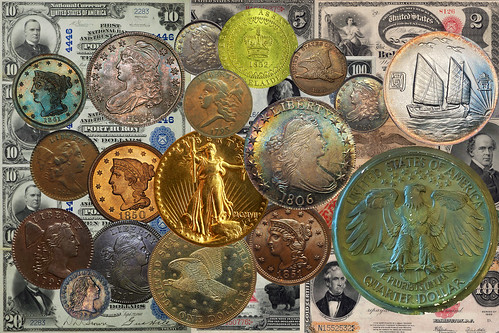
This auction will be conducted in accordance with prevailing Michigan Covid-19 guidelines at the time of the event, date to be announced and subsequent policy changes may affect the auction event location or timeline. Lot viewing will be available with observance of social distancing and P.P.E. by appointment only, prior to the sale at the firm’s Michigan office, located approximately one hour from Detroit Metro Airport with many hotels and restaurants adjacent to and nearby the auction convention center location.
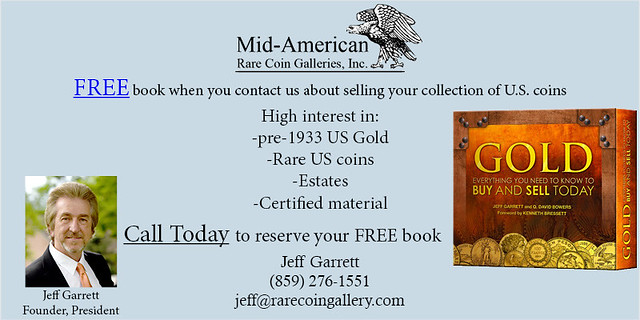
MEDAL OF HONOR FOR FREEING 70 ISIS CAPTIVES
The Washington Post reported of a September 11, 2020 Medal of Honor ceremony at the White House. -Editor
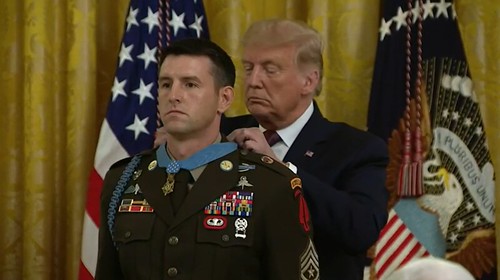
First Sgt. Thomas P. Payne peered through his night-vision goggles in the predawn hours of Oct. 22, 2015, midway through a daring prisoner rescue in northern Iraq. A fellow soldier had already been shot, and enemy fire roared just 30 yards away.
Payne, now a sergeant major, received the highest award for valor, the Medal of Honor, in a White House ceremony Friday for his role in the operation to free about 70 captives, a mission in which he led many out of the compound and went back in for one last man.
"He wouldn’t leave," President Trump said, describing Payne’s efforts. "He was the last man out."
Payne, 36, is the first service member to receive the award for actions in the fight against the Islamic State and the first living Delta Force recipient since the counterterrorism unit’s creation in the late 1970s.
Trump presented the award to Payne during a day of Sept. 11 commemorations. Payne enlisted months after the terrorist attacks and has served on 17 deployments, including to Iraq, Afghanistan and Africa — nearly one tour a year in elite units that have absorbed bloody costs of those fights.
The Army has said the mission was one of the largest hostage rescue operations in history. It was partially captured on the helmet camera of a Kurdish soldier, which shows Payne in a doorway leading a stream of captives out before going back to look for other survivors.
"I don’t consider myself a recipient," Payne told reporters at the Pentagon on Thursday ahead of the award ceremony. "I consider myself a guardian."
To read the complete article, see:
Soldier receives Medal of Honor after helping save 70 captives from execution by Islamic State
(https://www.washingtonpost.com/national-security/2020/09/11/medal-of-honor-payne-trump/)
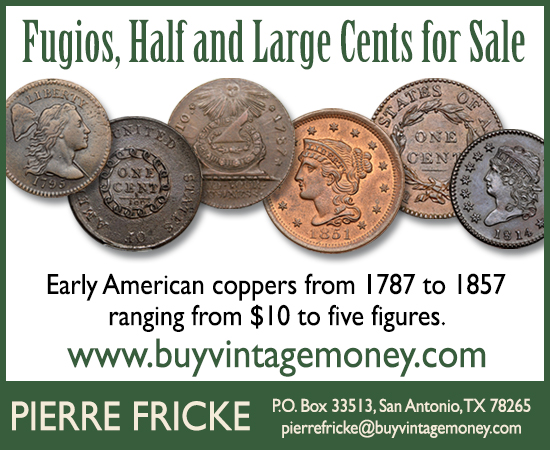
MUSEUM RECOVERS STOLEN BANKNOTE SKETCHES
Kavan Ratnatunga and Richard Miranda passed along this report. Thanks. -Editor
The BCRA Museum Recovered Stolen Paper Money Sketches
Argentina will [recover] eight stolen paper money sketches from 1935, 1941, 1948 and 1983 to the BCRA. They were about to be auctioned in the United States. The Department for the Protection of Cultural Heritage of the Federal Police together with the FBI's Art Crime Division-both part of INTERPOL International-recovered the works and delivered them to the Consulate General of Argentina in New York. In the coming days, the BCRA's authorities will receive the works in Buenos Aires.
In January 2018, the BCRA reported the disappearance of the sketches from the 'Héctor Carlos Janson' Numismatic and Historical Museum upon learning that some of them were on the verge of being put up for auction in New York. Once the Federal Justice ordered that the sketches be entered into the international database of stolen works of art, different international organizations began to work together.
The FBI's Art Crime Team got into contact with the numismatist that had the sketches in his possession. The collector, now under investigation, denied knowing that the sketches had been stolen and handed them in to the FBI. In turn, the court ordered their repatriation through the Ministry of Foreign Affairs of Argentina.
The sketches were handmade using different techniques. They were drawn by outstanding artists from the BCRA´s design department and the Mint House, and by designers from companies such as Thomas de la Rue and Waterloo and Son, which were hired by the BCRA after it became the monetary authority.
To read the complete article, see:
The BCRA Museum Recovered Stolen Paper Money Sketches
(https://www.marketscreener.com/news/latest/The-BCRA-Museum-Recovered-Stolen-Paper-Money-Sketches--31261229/)
The artwork was not pictured in the article. Perhaps there are images online - does anyone know which auctioneer had the consignment? Here is some more information about the collector and the museum. -Editor
September 30, 2019. Héctor Carlos Janson, the coin collector who donated the most important collection of Argentine patriotic coins to our museum in 2017, died in Santa Fe yesterday. Janson, the honorary life tenure president of the Academia Argentina de Numismática y Medallística, and author of the book La Moneda Circulante en el Territorio Argentino, was the most important private coin collector of Argentina.
"This was the best decision I’ve taken in my whole life", Janson said after handing over his collection, which he had gathered over more than 50 years of hard work and research. Thus, his collection became part of our collective heritage. On May 30, 2017, on the 76th anniversary of the Central Bank’s museum, Janson signed a deed of donation of more than 2,800 gold, silver and bronze pieces in a public ceremony where he was cheered by his family, friends, colleagues and authorities from the Central Bank. To show appreciation and recognition for his contribution of priceless historical value to the public cultural heritage, the Numismatic and Historical Museum changed its name to "Héctor Carlos Janson".
To read the complete article, see:
Héctor Carlos Janson, the Greatest Argentine Coin Collector
(http://www.bcra.gov.ar/Noticias/Janson-el-mayor-numismatico-argentino-i.asp)
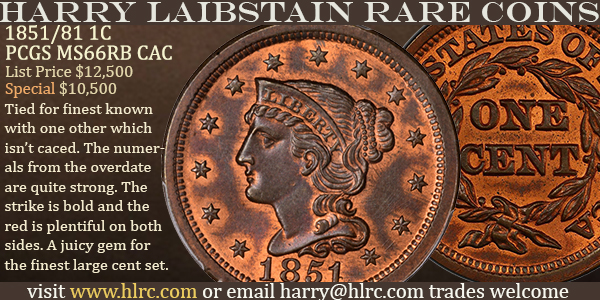
TUNISIA BANKNOTE HONORS FIRST FEMALE PHYSICIAN
Tunisia has released a new banknote honoring its first female physician, Tawhida Ben Cheikh. -Editor
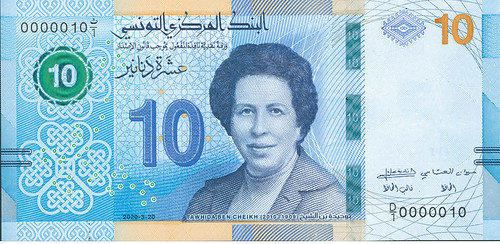
When a team from the Central Bank of Tunisia looked into redesigning some of their banknotes a few years ago, they knew they wanted to honor a contemporary figure on the 10 dinar note, someone who had made significant contributions to their country—who was, as Bank Governor Marouane El Abassi put it, "a bearer of Tunisian expertise."
They selected the late Tawhida Ben Cheikh (1909–2010), Tunisia’s trailblazing first female physician, as the face of the new banknote, which debuted in spring 2020.
Among many firsts, Ben Cheikh was the first female student in Tunisia to receive a university degree, in 1928, and reportedly was the first North African Muslim woman to earn a medical degree (in 1936, from the University of Paris). She is thought to be the first modern female doctor not only in Tunisia but in the Arab world.
Ben Cheikh has made history again, albeit posthumously, as the second woman to have her likeness featured on Tunisian currency. She follows Elissa (Dido), the legendary founder and queen of ancient Carthage, who first appeared on the 10 dinar banknote in 2005. The new banknote is also reportedly the first in the world to honor a female physician.
"I thought clearly that we need someone from the contemporary era," said El Abassi, adding that they were not explicitly looking for a female honoree. "After the revolution of a decade ago, we wanted the banknotes to be a mirror of the whole country."
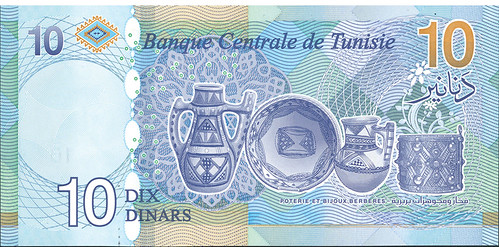
To read the complete article, see:
Tunisia honors the country’s first female physician on its 10 dinar banknote
(https://www.imf.org/external/pubs/ft/fandd/2020/09/tunisia-honors-first-female-physician-on-currency.htm)
THE BOOK BAZARRE
LOOSE CHANGE: SEPTEMBER 13, 2020
Here are some additional items in the media this week that may be of interest. -Editor
Forrest Fenn (1930-2020)
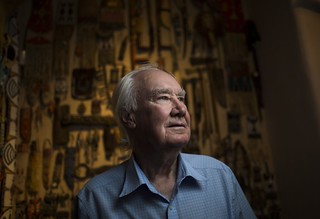 Forrest Fenn, an eccentric New Mexico art dealer who enticed thousands to search for hidden treasure after he announced in a 2010 book that he had stashed a bronze chest filled with gold nuggets and jewels somewhere in the Rocky Mountains, died on Sept. 7 at his home in Santa Fe, N.M. He was 90.
Forrest Fenn, an eccentric New Mexico art dealer who enticed thousands to search for hidden treasure after he announced in a 2010 book that he had stashed a bronze chest filled with gold nuggets and jewels somewhere in the Rocky Mountains, died on Sept. 7 at his home in Santa Fe, N.M. He was 90.
It came just three months after Mr. Fenn said someone had finally found the treasure chest, which held, by his estimate, $2 million worth of gold nuggets, sapphires, diamonds, pre-Columbian artifacts and other riches.
At least two people died trying to follow Mr. Fenn’s clues, and the chief of the New Mexico State Police urged Mr. Fenn to call off the hunt in 2017.
To read the complete article, see:
Forrest Fenn, Who Enticed Thousands With Treasure Hunt, Dies at 90
(https://www.nytimes.com/2020/09/09/us/forrest-fenn-dead.html)
Wife Sent to Prison in Rust Rare Coin Ponzi Scheme
The now ex-wife of a Utah rare coin dealer accused of stealing tens of millions of dollars in a silver trading scam told a federal judge Tuesday that she had no idea what her husband was doing until a month before authorities shut down their business.
But because she failed to tell police or investors, including her own family members, about Gaylen Rust’s alleged deception, Denise Gunderson Rust is headed to prison.
U.S. District Judge Ted Stewart sentenced Rust, 61, to 18 months behind bars and three years probation after she earlier pleaded guilty to money laundering. He also ordered her to pay restitution for $1.7 million she diverted from Rust Rare Coin, including a $12,000 check to her daughter, at her husband’s direction.
To read the complete article, see:
Wife of Utah rare coin dealer charged with fraud says she also is a victim before judge sends her to prison
(https://www.deseret.com/utah/2020/9/8/21427396/fraud-utah-ponzi-scheme-rust-rare-coin-federal-prison)

FEATURED WEB PAGE: THE DEXTER 1804 DOLLAR
This week's Featured Web Page is Mark Ferguson's Dexter 1804 Dollar book site. Suggested by Martin Kaplan. Thanks.
The Dexter 1804 silver dollar is one of the world’s great "story coins." Without its story, this coin would be just another high-grade proof, Draped Bust silver dollar.
This is the story of the Dexter Dollar, as told by "The Dexter Dollar Collection of Historic and Important Numismatic Literature and Works of Art."
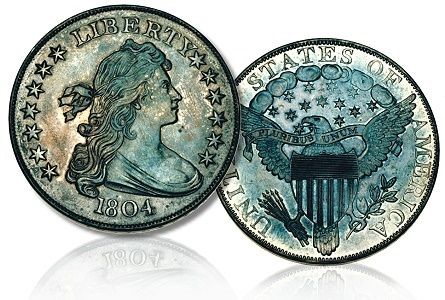
https://1804dollar.com/
